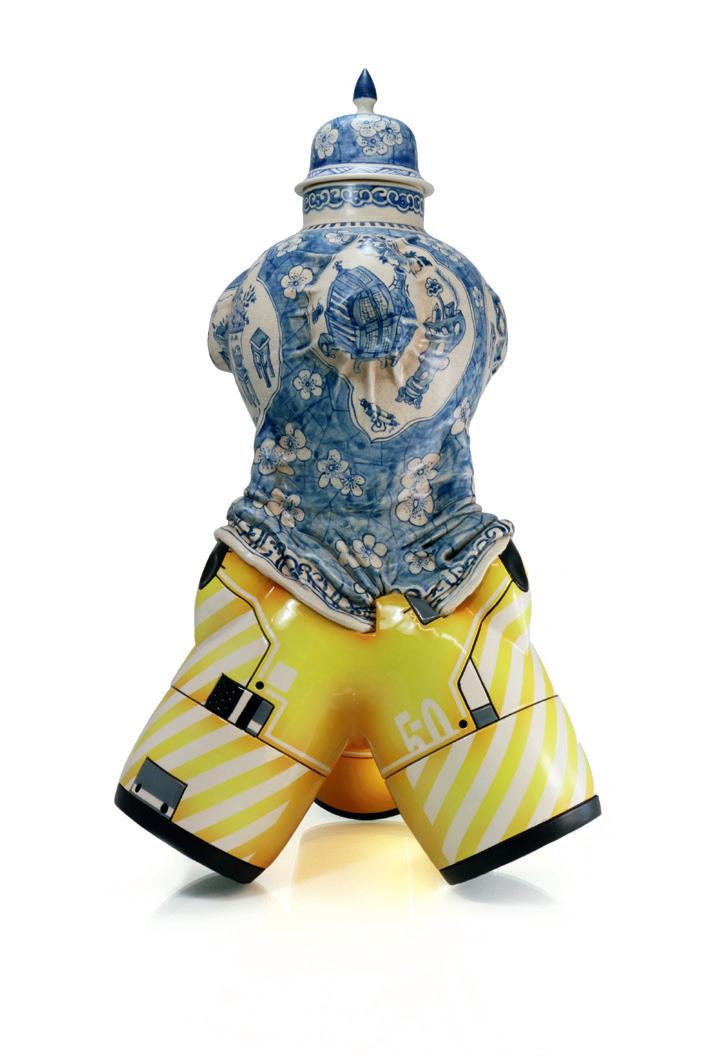Collectible furniture: The market is BOOMING!


Collectible furniture: The market is BOOMING!


FOUR INTERIORS WITH THE KEY TO PERFECT HARMONY
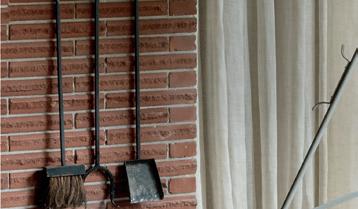
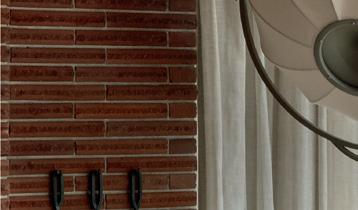


 Photos by Flavien Carlod and Baptiste Le Quiniou, for advertising purposes only. Ordrupgaard, architect Zaha Hadid. (1) Conditions apply, contact store for details. (2) Quick Ship Program available on select products in stock, subject to availability. Images are for reference only and models, sizes, colours and finishes may vary. Please contact your local store for more information.
In-store interior design & 3D modeling services.(1) Quick Ship program available.(2)
Cigale. Dining table, designed by Andrea Casati. Identities. Chairs, designed by Raphael Navot. Fleur de Coton. Floor lamp, designed by Alessio Bassan.
Photos by Flavien Carlod and Baptiste Le Quiniou, for advertising purposes only. Ordrupgaard, architect Zaha Hadid. (1) Conditions apply, contact store for details. (2) Quick Ship Program available on select products in stock, subject to availability. Images are for reference only and models, sizes, colours and finishes may vary. Please contact your local store for more information.
In-store interior design & 3D modeling services.(1) Quick Ship program available.(2)
Cigale. Dining table, designed by Andrea Casati. Identities. Chairs, designed by Raphael Navot. Fleur de Coton. Floor lamp, designed by Alessio Bassan.

9 Publisher’s Note
A foreword by Sophie Banford
10 Brief
What’s new, what’s coming and why we love it
18 Light Brigade
Three ingenious Canadian designers are rethinking interior lighting, and their creations are shining bright around the world
24 Twists and Turns
Architect Richard Tseng’s creative approach is all about movement, and now he’s designed a wine cellar that almost seems to flow
28 Origin Story
With Figura II, her latest collection of large-format sculptures, Quebec ceramicist Pascale Girardin channels a basic human trait: the need to belong STYLE
34 Windows on the World
Large bay and patio windows can frame what lies beyond the glass as if it were a painting, but certain rules apply. Meet two specialists in the field who are transparent about sharing their knowledge
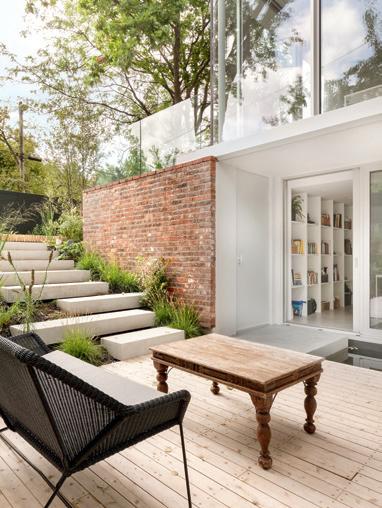
The Impala chair, designed by Sweden’s Gillis Lundgren in 1972, is now one of the most sought-after IKEA classics. In 2019, one example was sold at auction by Bukowskis for almost $3,000. Original price: $54.


The Swedish giant has brought attractive, functional, original design to the masses. Now, it’s becoming known for something much rarer: collectibles
A pair of kitchen experts who are top drawer when it comes to crafting beautiful and practical kitchens show us their pantry of tips
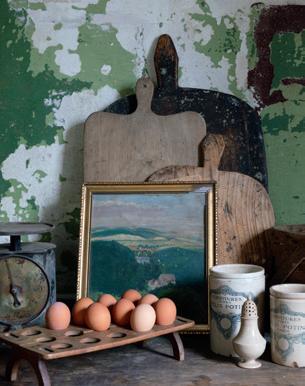
46 Blanket Statement
Merino, mohair, cashmere and alpaca: Pure-wool blankets are coming out of the closet

54
In a quiet North Vancouver enclave, a modernized mid-century retreat has gained new life in its leafy surroundings

68 Atta in Wonderland
An Ontario collector has turned a typical 19th-century farm into a showcase for treasures from the past
82 Time Management
Using a coherent approach and a dash of intuition, Toronto designer Ashley Botten maintained the spirit of a 19th-century interior while remodelling it for modern times


94 The Test of Time
In a project commissioned to Montreal’s La Shed, a typical NDG home regains its youthful splendour without selling its soul
110 A Truly Mobile Home
An aesthetically pleasing abode on rails that blends in perfectly with nature is now available in very limited editions
114 Perspective
A place, a moment in time, an emotion
115 Showstopper
A time-travelling object
In Vancouver, a Canadian and an Australian splendidly rejuvenated a mid-century modern home that had lost its lustre.


Publisher & Editor — Sophie Banford
Editor-in-Chief — Céline Tremblay
Art Director — Annie Lachapelle (Atelier Chinotto) Associate Editor — Anamika Butalia
Contributing Editor — Christopher Korchin Digital Director — Cynthia Quellet
Contributors
Maxime Brouillet, Donia Demers, Colin Faulkner, Muriel Françoise, Marouchka Franjulien, Stephany Hildebrand, Violette Létourneau, Emmanuelle Mozayan-Verschaeve, Louise Nadeau, Ema Peter, Zarya Rubin, Robin Stubbert
elledecoration@ko-media.ca
Senior Director, Strategy, Growth & Partnerships — Emmanuelle Giasson, egiasson@ko-media.ca
Director, Content & Strategic Partnerships — Alexandra Papineau
Strategist, Content & Strategic Partnerships — Noémie Quilleré, nquillere@ko-media.ca
National Sales Director (Toronto) — Marcelle Wallace
Sales Director (Toronto) — Marni Armour
Sales Director — Sandrine Dahan, sdahan@ko-media.ca
National Sales Director — Mariève Lemay, mlemay@ko-media.ca
National Sales Director — Natalia Tavares, ntavares@ko-media.ca
Sales Director (Strategic Partnerships & Insight) — Chantal Ferland, cferland@ko-media.ca
Supervisor Multi-Platform Projects — Tammy Hurteau
Multi-Platform Project Managers — Marie-Laurence Blais, Jeanne Bouchel
Production Coordinator — Daphné Chabot
Digital Sales Coordinator — Lou Ann Parent
KO MEDIA INC.
President — Louis Morissette
General Director — Sophie Banford
Director of Operations — Charles-David Côté
Marketing & Circulation Director — Marie-Andrée Picotte / Marketing & Circulation Project Manager —
Gaby Beaudoin / Special Projects & Marketing Manager — Claudia Tremblay /
Marketing & Distribution Coordinator — Alexandra Tobon
Special Projects Manager — Chantal Durand
Financial Controller — Rachel Bourdages / Accountant — Genta Cika /
Accounting Technician — Lyne Pelchat / Billing — Katherine Blanchette
Executive Assistant — Déborah Berthet
ELLE DECORATION® IS USED UNDER LICENCE FROM THE TRADEMARK OWNER, HACHETTE FILIPACCHI PRESSE, A SUBSIDIARY OF LAGARDÈRE SCA
CEO — Constance Benqué
CEO ELLE International Licenses — François Coruzzi
SVP/International Director of ELLE, ELLE DECORATION & ELLE GOURMET — Valéria Bessolo Llopiz
Creative Director of ELLE DECORATION & ELLE GOURMET — Linda Bergmark
Marketing Director of ELLE, ELLE DECORATION & ELLE GOURMET — Morgane Rohée
Digital Director of ELLE, ELLE DECORATION & ELLE GOURMET — Marine Le Bris
Syndication Director — Séverine Laporte / Syndication Coordinator — Johanna Jegou
Copyrights Manager — Kenza Allal
Pixelle Database Manager — Pascal Iacono

When I renovated my house in 2006, long before Pinterest and Instagram, my inspiration came mainly from international design magazines, such as the British Living Etc. and Australian Vogue Living. What struck me most about these two publications? The coexistence of old and new. I waited impatiently for every issue, whose pages featured furniture from contemporary designers and retro pieces rubbing shoulders—all in refurbished Victorian homes, where the cachet of the original structural elements had been preserved. Nothing was overly trendy or formulaic. Each space was creative, original and conveyed its own unique energy.
Having acquired a house dating from 1920, with a rather limited budget, I wanted to recreate those interiors where modernity blended cleverly with period charm. I opened up walls, enlarged the windows at the back of the house, painted the woodwork white—like the walls—and redid the kitchen with IKEA cabinets, which I paired with a large teak island.
I kept the rosettes on the ceiling, the fireplace mantle which I painted black, the magnificent solid-oak front door and the wooden staircase that was the hallmark of residential construction from this era in Montreal’s Notre-Damede-Grâce neighbourhood (you can see a version of this staircase and style of home in the article on page 94). Drawing on the inspiration found in my magazines, I wanted to create a bright, beautiful and cozy nest. A space that felt good to live in. The bet paid off, because 17 years later, my family and I are still living in the very same house that I love now more than ever.
Mixing genres is the theme of the issue you are holding in your hands. You will discover interiors that combine old and new, modern and vintage, wood and concrete. Let yourself, like me, be inspired by the contrasts! Happy reading! —

More than 10 years after sparking controversy by displaying a huge, beautiful chandelier made of tens of thousands of tampons at the Palace of Versailles, Joana Vasconcelos is far from running out of bright ideas. With the Bombom collection that she created for Roche-Bobois, the Portuguese artist invites herself into your home. Sofas, coffee tables, ceramics, the choice is yours, but expect a pop of colour. The ELLE Decoration team quickly fell in love with the Semi Frio, a tufted loop rug with concentric lines and a hypnotic effect. It’s designed for the outdoors, but with its tip-sheared pile trim, we also love it for the living room. — ($16,910, roche-bobois.com)
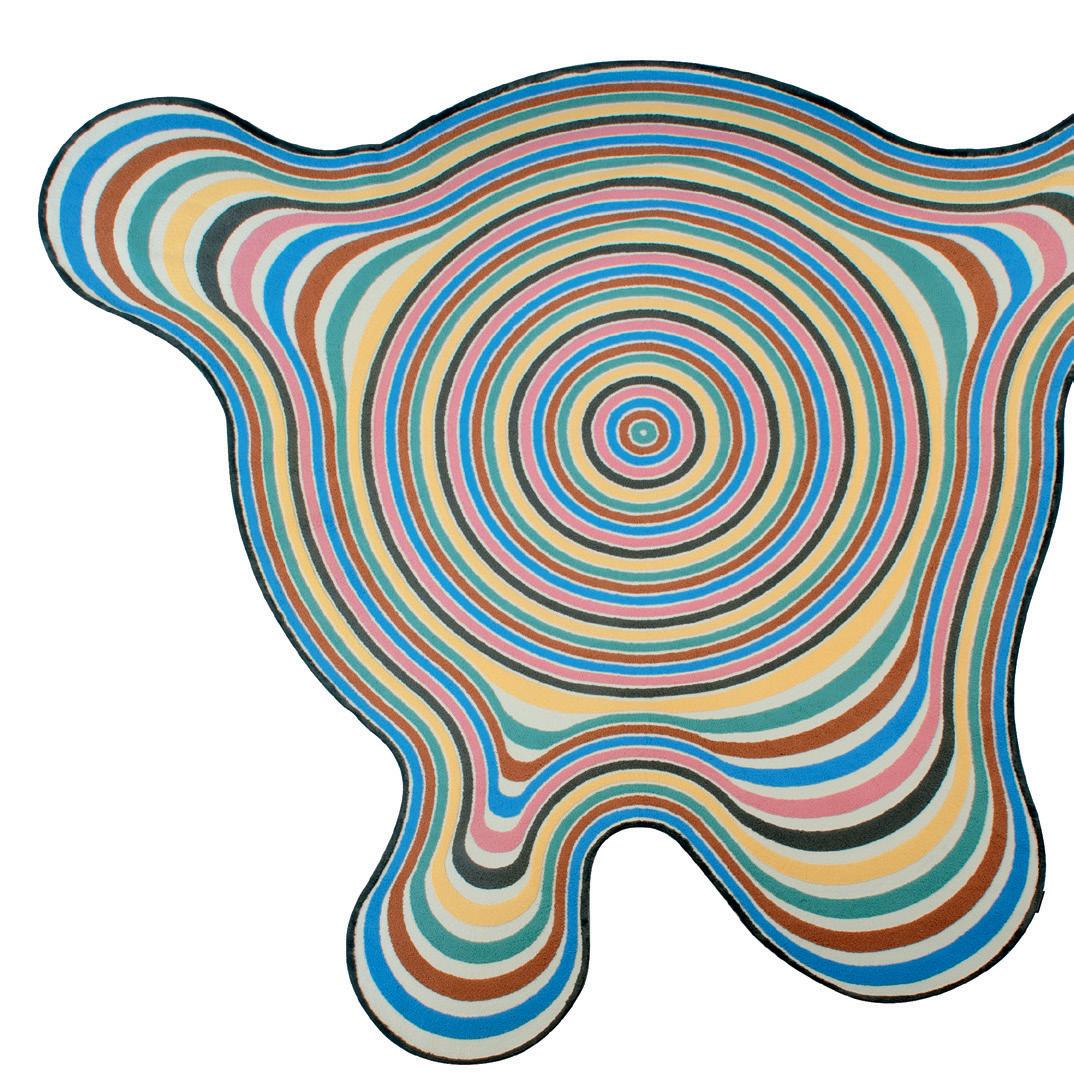
We searched, we found , we marvelled. Gaston Bachelard said, “Man is a creation of desire, not a creation of need.” WE AGREE .


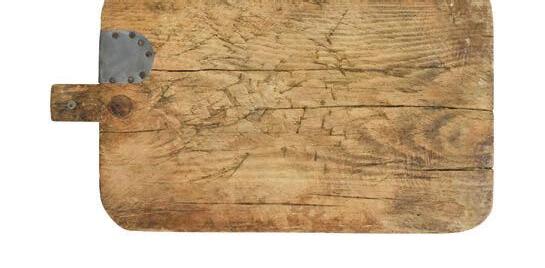
La Fabrique AllWood , a cabinetmaker and steel-welding workshop established in Montreal for nearly a decade, somehow slid under our radar. It’s the go-to for handmade and made-to-measure goods. Maple, cherry, oak and walnut are their locally sourced species of choice, but they have also chosen to work with Montreal trees felled following the ravages of the emerald ash borer. Good to know: Their latest collection, very aptly stripped down, is versatile in terms of shape and size as well as materials. Check out their website—you won’t regret it. — (factoryallwood.ca)


A few years before the time of Jesus, the Roman architect Marcus Vitruvius Pollio declared that every structure should be “solid [and therefore durable], useful and beautiful.” This still holds true in 2023. To this, designer Brian Lin would add that every structure should also evoke an emotion. Based on these principles, the Vancouverite designed this high-end brass incense burner. Hinged on three interlocking tiers, the case diffuses its wisps of smoke through the upper cover vent, burns the sticks in the middle compartment and stores them in the lower one. With use, the case acquires a patina that only increases its appeal. — ($600, populusproject.com)

Don’t try to find this cutting board. A discerning customer has already snatched it up. But don’t fret, there will be plenty of others at Maison Olive. Different, of course, but similar. Sabrina Ménard, mother of four young children, opened her boutique of carefully curated wares in Beloeil, Quebec; it used to exist only in virtual form. It’s love at first sight for everything vintage—including a series of fascinating terracotta vases—but we were also impressed by the entrepreneurial genius of this powerhouse of a woman, including the launch of a particularly elegant version of the Schoolhouse ceiling lamp. — (maisonolive.com)
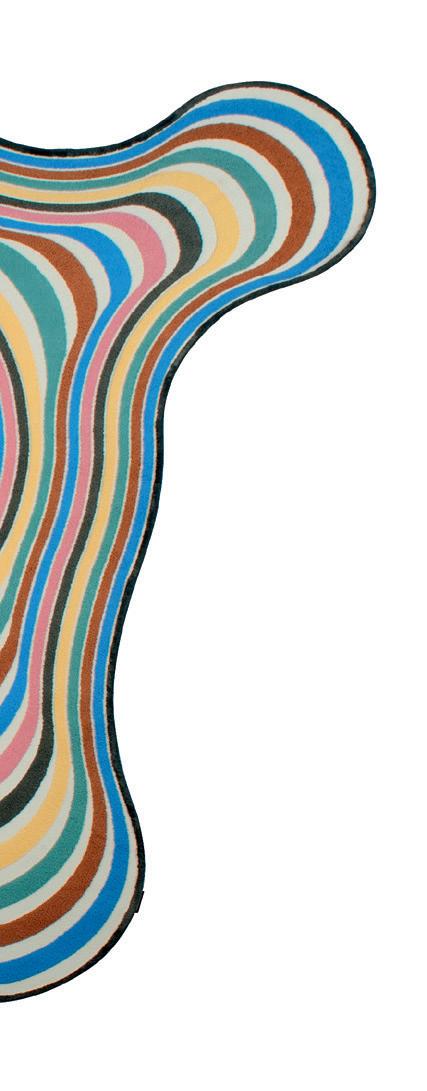
What happens when you merge the playful, creative genius of designer Gillian Segal with the natural stone and fine jewellery of Melanie Auld? The jeweller’s new flagship store in Vancouver, filled with cabinets of curiosities and brimming with whimsy. Melanie fans, take note: Her latest boutique is located in the heart of 4th Avenue. — (melanieauld.com)
With both its small and large appliances, Smeg is renowned for quirky style. From their retro refrigerators with rounded contours and playful colours, to a whole host of takes on the ’50s theme. Sadly, in North America we haven’t seen much of their limited-edition, completely fantastical and magnificently Sicilian collaborations with Dolce & Gabbana. But they also do understated, as evidenced by this collection of small appliances— coffee grinders, toasters, mixers, kettles, etc.—in pastel shades. Sweet. — (smeg.ca)

Last spring , Steve Morency, the new head of the Corcoran Group, decided to set up shop on Avenue Saint-Sacrement, in Quebec City. There, amid massive, natural wooden planks, customers get to give their sense of sight, smell and touch a workout. For a moment, you are transported back to the time of the log drive. Armed with sketches, will you be the first to challenge the craftsman to produce the long “river” table of his dreams? — (corcoranmobilier.com)

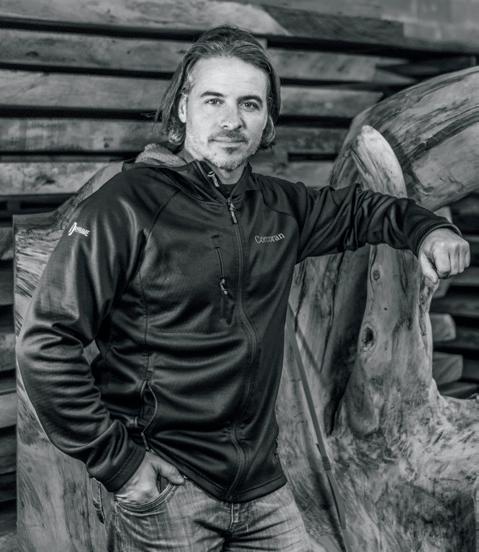


Rollout wallpaper can be found wherever you look in greater Toronto. On the walls of the Karl Lagerfeld and Broadview hotels. Dessert destination Demetres. Retail magnet Simons. The company’s mantra? Be brave. And break ranks. With Ghost, “an abstract ornamentation recalling paranormal emanations to create an otherworldly, dreamlike fantasy ambience,” contemporary artist and Rollout collaborator Paul Cook has done just that. Feeling brave? — (rollout.ca)







Let those who have never returned from a seaside beach vacation with a few treasured pebbles cast the first stones! Some are so special to the touch, it’s hard to leave them behind. Happily, Caesarstone has brought their rocky appeal, simplicity and warmth to a new line of five kitchen countertop surfaces. The collection, simply named Pebbles, comes in varying warm, grey, monochromatic tones. We love Stoneburst, which combines two sage greens and their undertones. So elegant, so durable! — (caesarstone.ca)



























Pia Metni , a self-taught Montreal artist, usually works with linen or raw canvas. Recently, she’s been drawn to paper embossing, and she now has a series of monochrome, minimalist abstractions heavily inspired by Bauhaus. Her warm, soothing palette tends toward beige, ivory, chalk and bone. — (piametniart.com)







If you’ve ever tried the Surya Spa at the Proper Hotel in Santa Monica, then you’ll love the Sabbya, in Montreal. Sleek lines, luxe materials, the spirit of relaxation. Just one look at the warm, luxurious, spacious marble steam bath with its vaulted ceiling gives you a preview of the well-being that’s in store. Bone-chilling November is the perfect time to experience this place. But also December, and January. And definitely February… Shall we go tomorrow? — (sabbya.com)
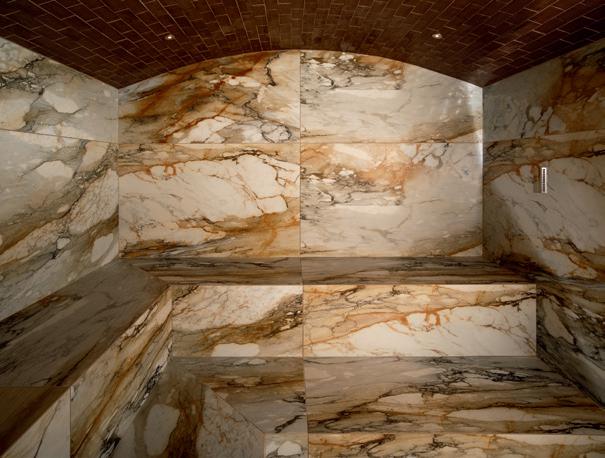
Sid Lee Architecture could not have more wind in its sails than on the 45th and 46th floors of Place Ville-Marie, Montreal’s iconic cruciform tower whose design dates back to the early 1960s. Thanks to them, Hiatus is now the top destination for an uplifting bird’s-eye view of the city for tourists, but also locals. Mixologist Tim Robertson (Nomi, Montreal) awaits you at the bar on the 45th floor, but the next level up is just as intoxicating. With chefs Yoann Therer (L’Abattoir, Vancouver), Iari Prassi (L’Île Flottante, Montreal) and Olivier Vigneault (Jatoba, Montreal) at the helm, the Franco-Japanese fusion flavours will make you feel like you’re in heaven. — (hiatus.ca)
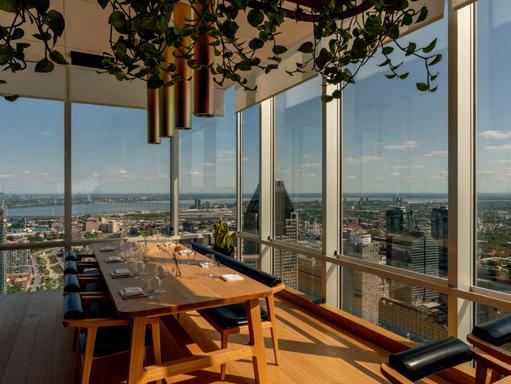
Japanese cherry blossoms , mountain dew, ginger and citrus, cucumber and honey: Luza creates luminous worlds to engage the olfactory sense, but which are also fragrance-free. We love this small company, started by three women from Quebec’s Eastern Townships who create locally made, lead-free, paraben-free, phthalate-free and GMO-free hand-poured natural soy candles, in three sizes (including a gigantic 56-ouncer). We also love that they offer moulded refills that fit in their hand-blown glass containers. — (luza.ca)
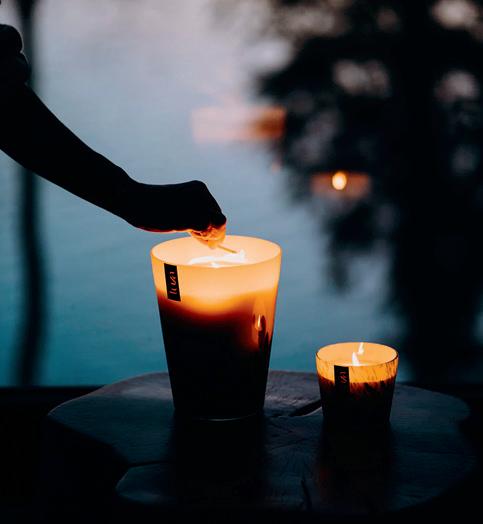
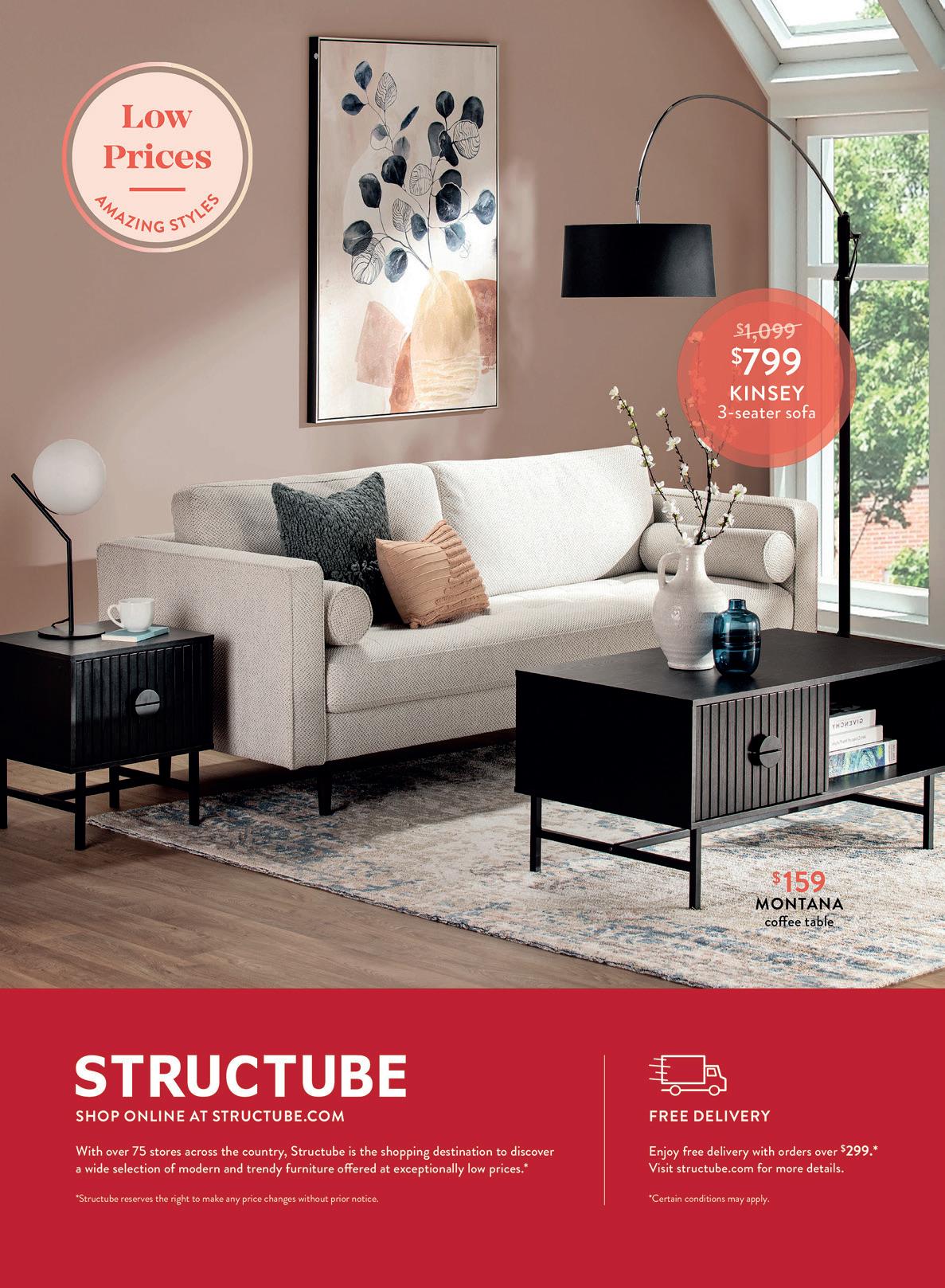
If you have recently taken a stroll down Rue de la Montagne, in Montreal, you were likely captivated by the window display at the Vogue Hotel. The radical transformation executed by Sid Lee Architecture stops you in your tracks. The space is compelling. Through the new glass facade of the building (LemayMichaud), the restaurant Yama (mountain, in Japanese), managed by Antonio Park, invites you to glide the back of your hand over its travertine bar counter while sipping a very cold Naked and Famous. Next time you go, arrive 15 minutes early to experience the lounge atmosphere in the hotel lobby. Look up at the colossal pendant light created by Lambert et Fils Studio, which makes quite an impression by the main entrance, opposite a floating fireplace laminated in mirrored bronze. — (voguehotelmontreal.com)
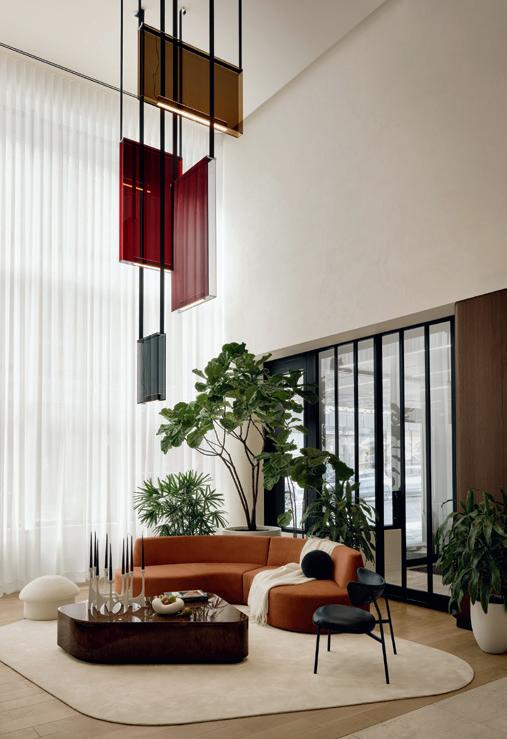
You have until October 1 to experience a tactile installation by four inspired and inspiring young creators— Marie-Pier Caron-Desrochers and Tristan Morissette (Studio Haricot), along with Rose-Marie Guévin and Vincent Ouellet—at the 24th edition of the International Garden Festival at the Jardin de Métis (a.k.a. the Reford Gardens), in eastern Quebec. The installation, made up of three hemp concrete shapes, is the culmination of their reflection on matter as a changing element in a world that is also in perpetual metamorphosis. The immersive experience, as much as the visit to the garden in all its autumnal glory, is well worth the trip. — (festivalinternationaldejardins.com) (jardinsdemetis.com)














 By Muriel Françoise — Adapted by Christopher Korchin
By Muriel Françoise — Adapted by Christopher Korchin
As a graduation gift to himself, Philippe Malouin purchased two Parentesi lamps by Achille Castiglioni and Pio Manzù, from Flos. A decade later, the Quebecer, now based in London, can take pride in being the only North American designer to have his works produced by the famed Italian firm. His Bilboquet table lamp, presented last spring at the Euroluce show in Milan, was inspired by his Nylon Turntable, which sits atop ball joints. “I had some small magnetic ball joints in my studio,” says Malouin. “I thought they would be a great way to connect the elements to make an adjustable lamp.” Ideal for lighting a workspace or creating atmosphere by directing a module toward a wall, it can also be attached to a side table with its handy clip. “It’s perfect for people of my generation who don’t have large apartments but who want to live well and have quality items,” he adds. — (flos.com) (philippemalouin.com)



Sculptural yet functional, these new indoor LIGHTING pieces are getting glowing reviews. We spoke to three ingenious Canadian designers whose creations are shining bright all around the world.


After exploring the sophisticated styles of ancient Greece as inspiration for his Column collection, designer Lukas Peet turned his focus toward raw materials for his new series, whose slightly inclined sections shed angled light, drawing attention to their casual, unfinished quality. His streamlined steel Vector lights channel the Brutalist architectural style of which so many fine examples, like Montreal’s Olympic Stadium, are found in Canada. “While things are often admired for their perfection, I wanted to go back in time and pay tribute to the material’s authenticity by using simple forms, which is much more emotionally appealing,” explains the A-N-D co-founder. Three finishes mean these lamps can complement different interior styles. A weathered steel surface, for instance, contrasts with the highly technical aspects of these pieces, designed in Vancouver. “The rich texture diffuses a warm glow that is particularly well suited to dining rooms and living rooms,” says Peet. —
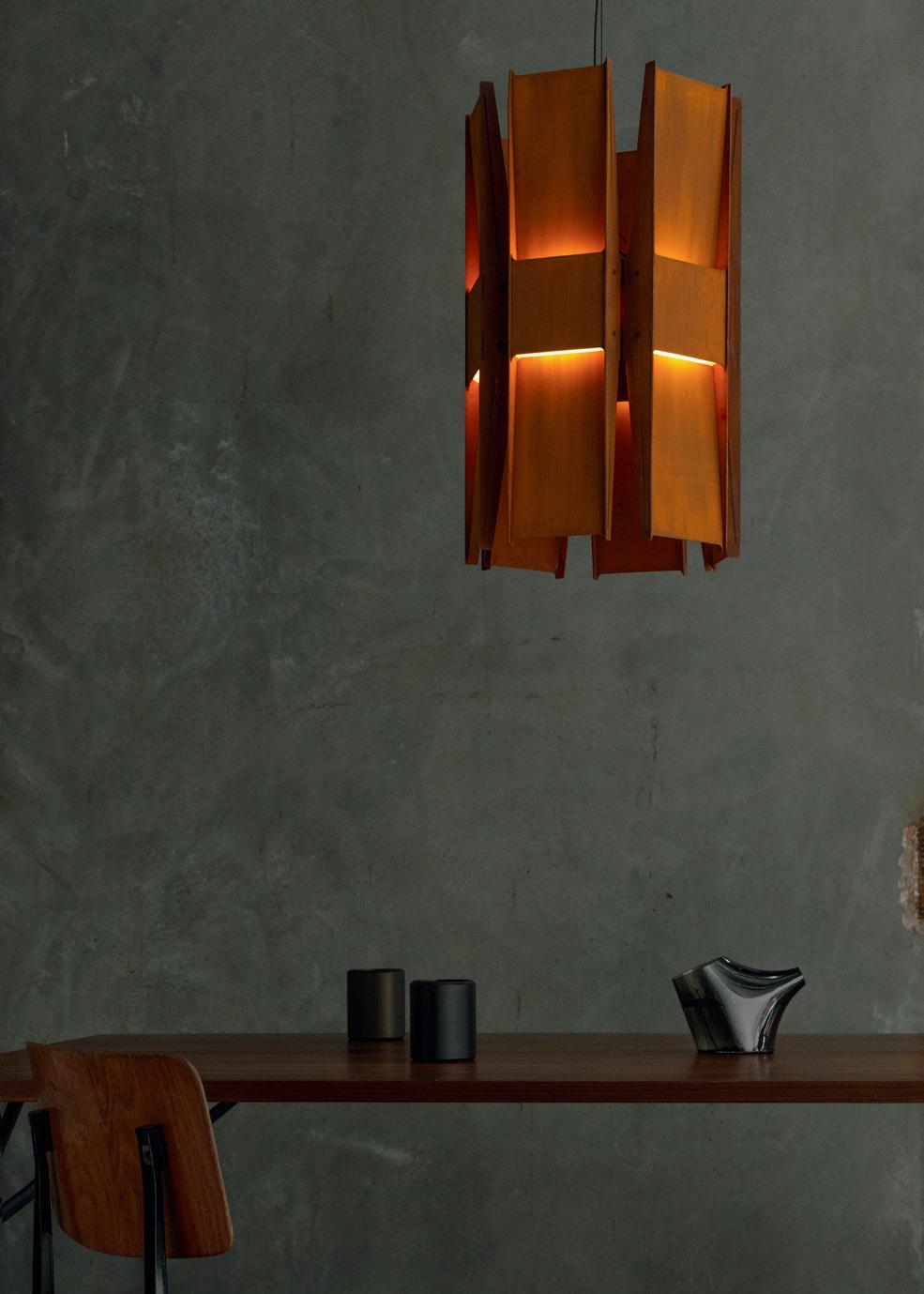
($1,225, a-n-d.com)


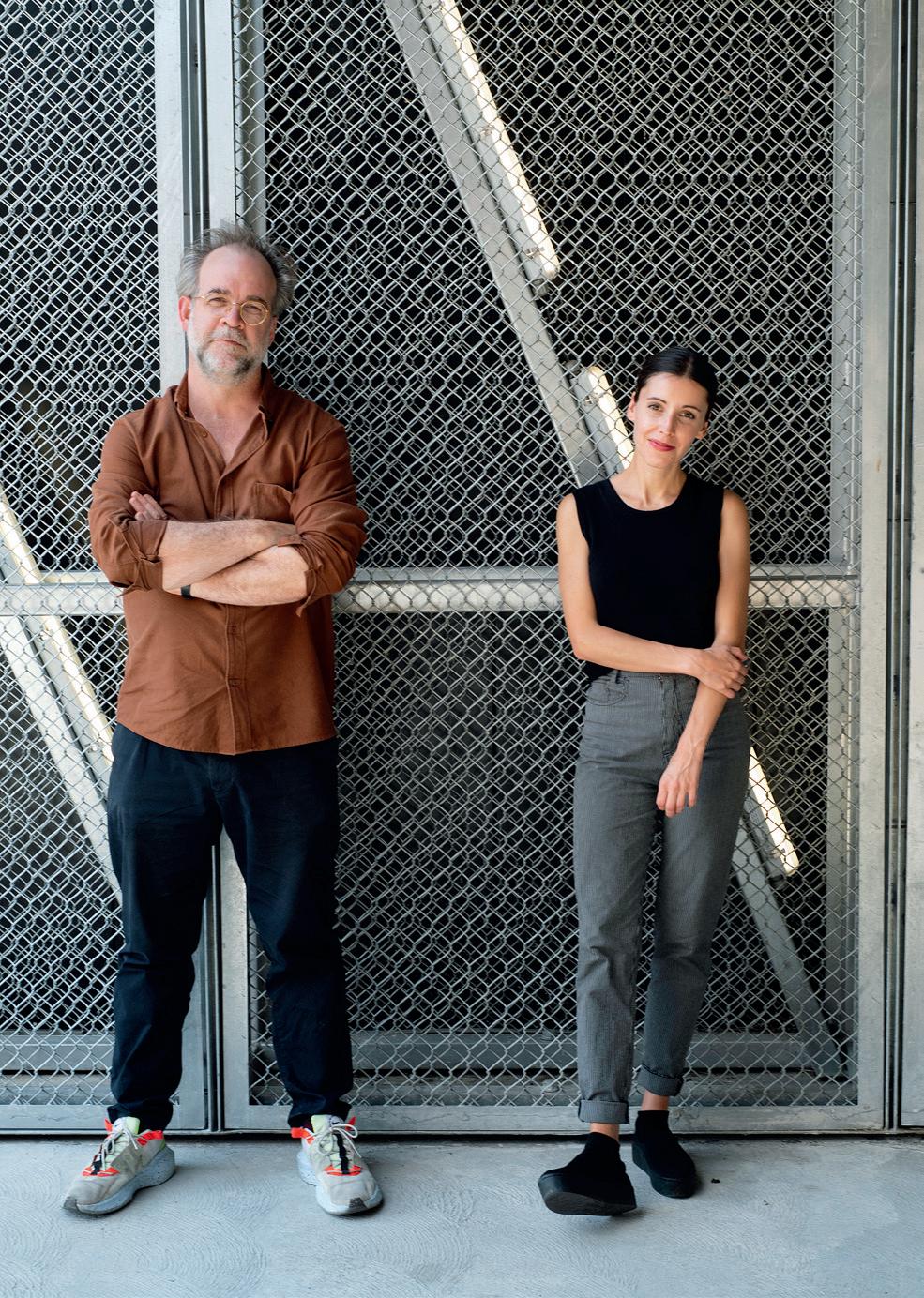
The new Isle collection of hanging lights, created by New York-based designer (and Edmonton native) Zoë Mowat, in collaboration with Montreal manufacturer Lambert & Fils, are a bit like mobiles in their ability to capture—and hold—one’s attention. “In the beginning, I was designing more decorative pieces that could grow and expand in different ways,” says Mowat. “I was very sculpturally driven. I was interested in solid blocks of materials, in waving, suspending and celebrating them by having the light reflecting on them.” Although industrial production constraints led Mowat to go down a different path and to work with light as a material in and of itself, her lamps nonetheless have an aura about them that goes beyond their domestic setting. A glass tube, double-sided and depolished, combined with blocks of marble and aluminum that resemble sculpture pedestals, gracefully illuminates any room it floats above. Six styles and three lengths allow hanging arrangements that almost evoke bridges, like the ones separating Montreal from Manhattan. —

(From $5,040, lambertetfils.com)



Taiwan to Buenos Aires,
Montreal and Toronto , architect RICHARD TSENG is as peripatetic as he is productive. Through financial challenges, the legacy of a passionate dad and a series of formative encounters, he has managed to set down roots all over the world while still riding the waves and maintaining a nomad’s global vision.
 By Violette Létourneau — Adapted by Christopher Korchin — Photos by Colin Faulkner
By Violette Létourneau — Adapted by Christopher Korchin — Photos by Colin Faulkner
When Richard Tseng talks about his career path, you realize very quickly that his persevering nature, love of architecture and belief in collaboration all come from his father. His entire life, Yao Ming Tseng dreamed of becoming an architect. But in Taiwan, the logical choice when you weren’t rich was to be a teacher, with your education being funded by the government. His son could achieve his dream for him.
Before they immigrated to Argentina, the Tseng family built houses in Taiwan: The grandfather had the land, the uncle the funds, and the father the desire. Even as a young boy, Richard immersed himself in the world of architecture. Later, in Buenos Aires, Yao Ming earned a living building houses and doing renovations. And he was always interested in his son’s opinion of the work.
Richard remembers renos on an apartment across from the family home, above a store, another side gig to make ends meet. “It was small, a bit tight. Instead of creating a narrow hallway, I came up with the idea for a rounded corner that would lead to the living room, to open up the space. And my father did it.” At the age of 14, he was used to being encouraged by his father to give his opinion and having his sketches praised—but for his dad to listen to one of his ideas and then carry it out was unexpected. And exciting. Yao Ming had sparked something.
Several years later, when Richard was in his first year of architecture school in Los Angeles, his father died, all too young at 52. His death brought financial hardship for the Tseng family, but they all agreed that this was not going to compromise Richard’s studies. Which is how he wound up in Montreal, staying with a friend from Argentina. But despite the reduced cost of living and easy access to public transport, he led a precarious existence and his status as an immigrant didn’t help. Feeling unmotivated as he mourned his father and faced such challenges, he continued his studies at Concordia University, but struggled to apply himself.

His French prof noticed his frequent absences, and told him: “Your sadness and anger are going to have to come out one way or another. You have the right to be happy. Your father would be happy if you are.” Those words gave Richard the strength to get through this dark period. A few years later, when he obtained his master’s degree in architecture from the University of Toronto, he was indeed happy. But his father wasn’t there.
Richard recalls: “My father used to tell me, you speak the three most useful languages. Spanish, the language spoken in the greatest number of countries; English, the international language; and Mandarin, the most spoken language in the world.
“My dream was to become an architect and build things with my father. But my father is no longer here.”
— Richard Tseng
Wherever you go, you’ll be able to communicate. That’s why I love to travel—I can make friends everywhere.” Such encounters also provide inspiration. Even though he is less nomadic nowadays than when he used to change countries every four years or so, Richard still travels regularly in Asia, Latin America and Europe, searching for new ideas and novel sights. Just like before.
The architect has always been drawn to Milan, and he acted on that by applying for a job at Lissoni Associati—Piero
Lissoni and Nicoletta Canesi’s celebrated design and architecture studio. Asked to come for an interview, he packed his bags and left Taiwan to settle in Milan, a leap of faith that Canesi remarked upon when she noticed his luggage: Richard had come directly from the airport. Well, he would start work the following morning. A sigh of relief.
It was the beginning of a highly invigorating period. Working in Milan meant collaborating with designers from all over the world and rubbing shoulders with all sorts of inspiring people who come to this design capital to show what they can do and soak up the latest innovations in the field. “These are people who don’t take themselves too seriously—their work culture really appealed to me. We worked hard and also partied hard. We’d come back to work after staying up all night. Let’s just say we didn’t sleep much! But it’s so stimulating, having these dual ways of expressing yourself. I loved it, and I learned so much.”
A team player, Richard likes to work in this spirit of collaboration—the key to better design, in his opinion. “The process can be painful. But it’s those very tensions that come along with collaboration that prompt new ideas and really improve the result. My goal is for everyone to be in love with the result: the entrepreneurs, the clients, the builders and installers, everybody.” Since the start of his career, Richard has collaborated with the interior designer Mia Chung, who happens to be his partner and wife. And even then it’s not always smooth sailing. “I prefer someone who questions what I’m doing to someone who tells me everything is perfect. I need to be second-guessed, to be given a hard time or be made to realize that I’m wrong. That’s how you find better solutions.” Together, the creative duo gets back to the drawing board, erases, redesigns, reconfigures, until everyone is happy.
One of Richard’s latest projects, a cellar and cigar lounge in the home of a client in North York, Ontario, is also the result of a delicate collaborative effort. “I knew there was going to be friction between my vision and the way the entrepreneur who was handling the construction liked to work.”
Richard did not want a run-of-the-mill layout, but to add his touch, he needed to sell him on his ideas. “I spent three times longer than usual on the project. I did twice as many drawings. But he doesn’t read drawings! He’s been working that way for 30 years,” he says, laughing. So Richard worked with the entrepreneur on-site, explaining to him not only what he wanted to do, but why he wanted to do it. “It was a really big challenge, I had to convince him to follow along with me. But once he understood what I was trying to do, he was all in. If he believes in something, he does it. Whatever it takes.” A slightly rocky collaborative experience, all in all, but it won’t be their last.
Long before working on the cellar and cigar lounge, Richard had the chance to get to know his client. He had done the initial renovations on his home, more than a decade earlier, and had brought him over to Milan a few years ago. “That allowed him to better understand my work, and allowed me to better understand his tastes, his style. He’s someone who has always wanted unique, eccentric, different things.” Richard wanted to do something special for his wine-loving client. In a tight space, he therefore created a dual-purpose room, where cigars and bottles flow together naturally.
“I started by thinking about smoke, and liquid, and water,” explains Richard. “The way smoke rises like a mushroom, and the way water rolls and flows, like a wave. I needed to evoke a feeling of fluidity, of movement.” So he used software and an image of the ocean to create depth, with the positive and the negative of the waves in the picture.
On the walls of the cellar, the displays are extended by walnut uprights that provide a warm look and stretch out to join with the waves that undulate across the ceiling. A sophisticated, delicate, complex design, roundly flowing and in constant movement. And a unique space, brought together through the use of curves. Life is not a straight line, and in following its twists and turns, Richard Tseng has indeed made his father’s dream come true. —
(omddesigninc.com)
“Chemistry and confrontation are a part of collaboration. And when you reach the end, you realize you have made something better.”
— Richard TsengBy Véronique Harvey

The need to belong is a universal, instinctive human trait. Each of us wants to be part of a community, identify with a group, discover where we came from. And this desire is precisely what Quebec ceramic artist PASCALE GIRARDIN is channelling with her latest collection of largeformat sculptures, Figura II.— Adapted by Zarya Rubin — Photographs by Stephany Hildebrand Each of the highly abstract sculptures in the Figura II series suggests the human body by way of its size, curves and colours.
“It’s the material that speaks to me. It’s a dialogue, an exchange. I watch how the clay reacts, how it behaves, in order to better work with it. The clay itself gives me ideas.”
For Pascale Girardin, art is always an outstretched hand, a way of seeing how people sense and interpret things. Thus the importance of the abstract nature of her works.
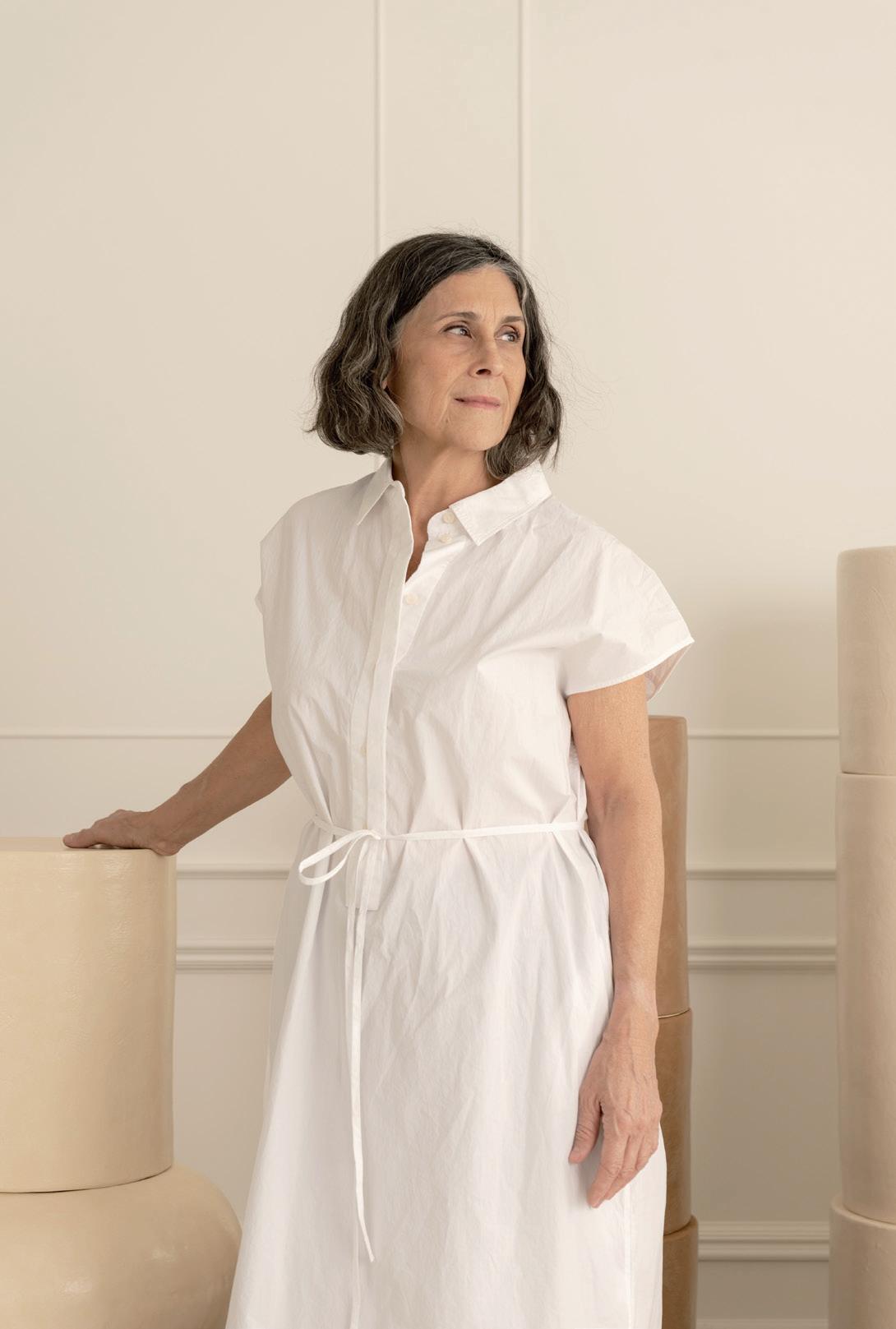
This collection is the second in her series of totemic figures that she began three years ago, following a height challenge handed to her by an exhibition curator. Alone in her studio, in the midst of the pandemic, the artist playfully developed her pieces, adding vertiginous curves, to see how far she could go in stature and roundness, balancing the limitations of technical challenges.
“As I worked, I had to move my pieces, which were quite large. So I had to embrace them using my whole body in order to transport them, and I started to feel like they were human beings. This got me thinking about the relationship between mother and child,” explains Pascale Girardin.
And in this dialogue with the material, in the act, the gesture, the yielding of the clay, the notion of totem poles slowly began to emerge. “The totem pole, by definition, is a physical manifestation of the history of a community. The origins of a group and its customs are conveyed by the stacking of different symbols,” says Girardin, who realized she was onto something. It was from this moment on that she decided to go deeper into her research on the notion of origins.
Having moved several times during her youth, the question of origin is one that the artist has personally been confronted with since early childhood. Every time she landed in a new city, she tried to adapt, to take on the local customs and traditions, in the hopes of one day belonging to a community. This link between art and life has thus allowed her work and the way she views it to come full circle. “I strongly believe in the process. Mine is slow—this one stretched out over a period of two years—but it has produced a body of work that is more grounded, a more sincere and honest approach. For Figura, for example, it is not an appropriation of the totem pole representing the First Nations. It is the notion of belonging that emerges from all of this that I’m trying to express,” explains the artist.
Each sculpture in the Figura II series—between 15 inches (38 cm) and 60 inches (153 cm) in height—is abstract. But in their size, their curves and their colours, there is something that evokes our relationship to the human body. The subject matter is not obvious, of course, but it is entirely plausible.
“When you try to control the message too much, it becomes communication more than art,” says Girardin. “So I prefer not to reveal everything. For me, art is more nuanced and open. It allows you to reach out to others, to see how they feel and interpret things. I apply the same principle with clay: I don’t involve myself too much, I try to see how we can dialogue, and what it can teach me.”
Between her personal collections and her private commissions, Pascale Girardin sometimes finds herself involved in fortuitous collaborations. This is how the Quebec ceramist recently joined forces with artist and designer Maud Beauchamp to put together a collection of light fixtures entitled Dunes.
“When we decided to do a small project together, it was Maud who suggested lights. Then she came up with a round light bulb, which she offered as a starting point.”
Although the image of the pearl imposed itself early on, after many discussions, some sketches and a first composition, the duo finally agreed on the final concept. “We settled on the idea of a lunar landscape, the moon that we see through the dunes, hence the desert shades chosen.”
The project fits perfectly with Girardin’s contemporary but timeless style.
And the artist, who is currently working on the third instalment of her Figura series—where the colours this time around will tend more toward shades of brown and caramel—hopes to engage in more collaborations of this kind, which she views as highly rewarding from a creative point of view, in the near future. Interested artists, take note! —
(pascalegirardin.com)
“As much as I love bright colours, I never end up using them. I always go back to natural colours. I’m drawn to them.”

“I try to capture something universal, something that humans have in common. I deal in our common experience.”The result of a collaboration with artist and designer Maud Beauchamp, the Dunes lighting collection represents those magnificent lunar landscapes one sees in sand dunes as they shift and are transformed by the wind.

Windows on the World (PAGE 34) Large bay and patio windows can frame what lies beyond the glass as if it were a painting, but certain rules apply. Meet two experts in the field who are transparent about sharing their knowledge IKEA: From Temporary to Timeless (PAGE 38) The Swedish giant has brought attractive, functional, original design to the masses. Now, it’s becoming known for something much rarer: collectibles —
What’s Cooking in Kitchen Design? (PAGE 42) A pair of kitchen experts who are top drawer when it comes to crafting beautiful and practical kitchens show us their pantry of tips — Blanket Statement (PAGE 46) Merino, mohair, cashmere and alpaca: Pure-wool blankets are coming out of the closet

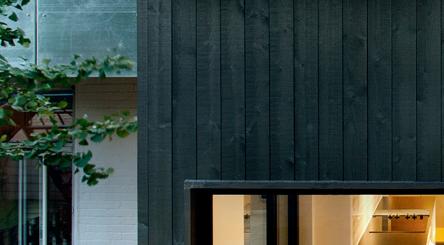
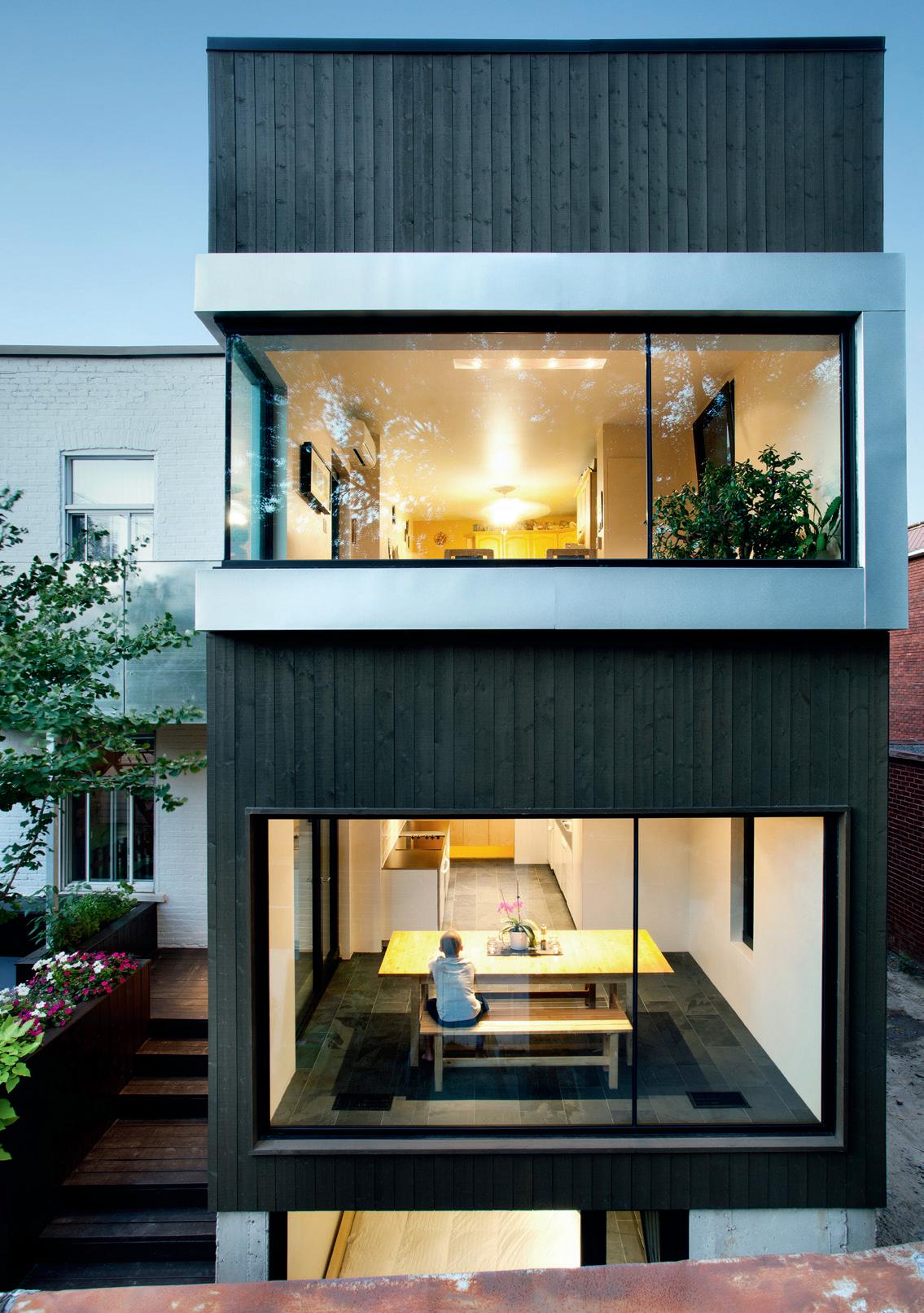 This project, created by Montreal architecture firm Nature Humaine, with glazing supplied by Alumilex, demonstrates the grand possibilities of glass with the ALX 2060 series.
Opposite page — Seen from the inside, the Maison du Parc glazing gives the space a New York feel.
Photo: Adrien Williams
By Emmanuelle Mozayan-Verschaeve — Adapted by Zarya Rubin
This project, created by Montreal architecture firm Nature Humaine, with glazing supplied by Alumilex, demonstrates the grand possibilities of glass with the ALX 2060 series.
Opposite page — Seen from the inside, the Maison du Parc glazing gives the space a New York feel.
Photo: Adrien Williams
By Emmanuelle Mozayan-Verschaeve — Adapted by Zarya Rubin
The humble window , once considered a sign of wealth in the 19th century and early 20th century in many European countries, was subject to tax: A double-glazed house was a reflection of a doubly rich owner. This little piece of history allows us to reflect on our current world, where the quest for a home that offers equal parts indoor and outdoor living is all the rage. The arrival of the curtain wall has met this desire, or dare we say need, to fuse the external environment with the interior one. Bay windows are becoming essential elements in the majority of new constructions, a far cry from most older homes with their relatively modest fenestration. “In the past, windows were primarily used for ventilation and to let in at least a bit of natural light. They were small so as to prevent substantial heat loss and keep things comfortable during the winter,” explains Christine Hébert, sales representative and project manager at Alumilex. The lack of energy efficiency previously hampered the incorporation of large window walls in residential dwellings, but today, technological advancements and innovations are changing the game. Hébert sees a trend
toward increasingly large, increasingly streamlined surfaces producing an effect of complete transparency.
The advent of triple glazing offers a wide range of possibilities, particularly in terms of orientation. In the past, northfacing walls were windowless because of the need to retain heat. Now, the thermal efficiency of windows composed of three panes, separated by an insulating layer filled with inert gas, means they can be installed on any wall of the house. “The new glazing has low-emission films that act as a filter, preventing overheating indoors in summer and conserving heat in winter,” explains Hébert. Triple glazing also significantly reduces surrounding noise and vibrations, which can be particularly important in an urban environment. For all its wonders, triple glazing is no substitute for an adequately insulated wall; although it can enhance the energy efficiency and soundproofing of a modern building equipped with a good heating system, it’s not much use in an old house where the insulation leaves something to be desired. ↦

Both strong and breakable, GLASS has a certain duality, intimately linking us to the outside world and protecting us from it at the same time. Let’s shed some light on this essential material of our contemporary living spaces.Photo: Maxime Brouillet
And although next-generation windows can adorn any side of the house, aesthetics determine their placement. Architectural, ecological and environmental concerns are also key factors to consider, requiring considerable thought and careful planning. “Nowadays, it’s more accessible for everyone to put in large windows,” says Hébert, “but you should never neglect the basic concepts, in addition to taking into account what already exists in the context of a renovation, such as heating sources and sealing.” Indeed, all the windows must coexist in harmony with the proportions and style of the house, then be positioned in specific locations according to sun exposure and where they will offer the best views.
The window frame, an essential and integral element for the insulation, performance and appearance of any window, can take the form of PVC, aluminum or wood. The first has a lower price tag but is less durable and less elegant than other materials. The second, minimalist and refined, is also distinguished by its structural integrity, resistance and undeniable sleek look in every shade, but it is more expensive. As for wood, the classic complement to the country estate, it requires regular maintenance and is extremely expensive.

Mélodie Violet, founder of the agency Imagine, has also noticed a growing infatuation with large modern-style bay and patio windows and doors. “We consider them to be like an outward-facing painting, and we try to place them strategically, depending on the importance of a particular location and the number of times we will be there every day.” When this interior designer was starting out, patio doors were typically six or
eight feet wide, but now those sizes have doubled. Bringing the outside in, bay and patio windows are in high demand, and interiors must be designed as a whole for them to be functional—such as combining the dining room, the kitchen and the patio. She often favours a configuration of three or four panels, which are easier to handle, and fixed glass inserts limiting the number of insect screens. “Where structurally possible, I like to incorporate corner windows, because they give a unique and pleasing perspective.” Opting for a very thin frame, ideally in aluminum, and remembering to match the hardware, ensures a high-end look. Another important point: Don’t forget window dressings, because it gets dark very early for six months out of the year in this country, and the wonderful panoramic view of the courtyard during the day quickly turns into a black hole once the sun sets. Enveloping curtains, in linen or velvet, bring texture and warm up a bay or patio window, which can seem cold when it gets dark. Be bold and use mustard, raspberry or forest-green tones to enhance the space, or tone-on-tone patterns in neutral and warm shades if you prefer a natural and organic look. Three-ply curtains, sumptuous and timeless in any setting, hung on a rod recessed in the ceiling or fixed flush with it, will accentuate the height and presence of a large window. In the end, Christine Hébert and Mélodie Violet suggest focusing on quality above all, putting more emphasis on the location of the window, rather than its size. When integrated into the design of the home and beautifully crafted, windows are an essential part of the total package and most certainly add value. — (alumilex.com) (studiodesignimagine.com)
“We mostly live in enclosed spaces. They make up the environment in which our culture is created. Our culture is, to some extent, a product of our architecture. If we want to take our culture to a higher level, we will be, for better or for worse, forced to transform our architecture. And this can only be possible when we have rid the spaces in which we live of their enclosed character. We can only achieve this if we adopt glass architecture, which lets in the light of the sun and the moon and the stars not only through a few windows—but through as many walls as possible, all of which are made of glass. The new environment that we will then create will produce a new culture.”


 — Paul Scheerbart, author of Glass Architecture, 1914*
*Adapted from erudit.org
Photo: Adrien Williams
Opposite page — The La Binocle project, by architecture firm Nature Humaine, seen from the inside
Perched on a clifftop in Quebec’s Eastern Townships, La Binocle (Nature Humaine) uses glass (Alumilex) as a kind of camera trained on the environment.
— Paul Scheerbart, author of Glass Architecture, 1914*
*Adapted from erudit.org
Photo: Adrien Williams
Opposite page — The La Binocle project, by architecture firm Nature Humaine, seen from the inside
Perched on a clifftop in Quebec’s Eastern Townships, La Binocle (Nature Humaine) uses glass (Alumilex) as a kind of camera trained on the environment.
 By Céline Tremblay — Adapted by Christopher Korchin
By Céline Tremblay — Adapted by Christopher Korchin
1981. I had just bought my first sofa at a Catholic thrift store in Quebec City—a burgundy velvet three-seater from the 1920s that weighed four tons—when Brigitte, a colleague in her early twenties, like me, told me that with the $2,000 in hard cash that she had saved up, she was planning to fully furnish her first apartment. And how was she going to do that? By heading to…IKEA. She was surely one of the very few in the province to even know about the Scandinavian brand (the very first Canadian outpost opened its doors in 1996, in Richmond, B.C.). Now she was counting the months, weeks and days until it arrived in Montreal. Huddled around her catalogue, lusting after its contents, we were drawn in by a sudden and unprecedented entrée to what felt like…modernity.
Forty years later, as the company celebrates its founding 80 years ago, just one of Brigitte’s IKEA armchairs could fetch more money than the total amount she spent to furnish her nest. Indeed, against all odds, IKEA has increasingly become a prized name on the auction market. Although its products were above all designed to be affordable, and therefore not necessarily long-lasting, those examples that made it past the half-century mark are now appreciating in value. And the
Opposite page — Ingvar Kamprad, in his prime. He was just 17 when he founded the company in 1943. The name IKEA is an amalgam of his initials and the first letters of the name of the family farm and his hometown.
Gillis Lundgren designed nearly 200 models for IKEA. Among them are the Billy bookcase, the Impala lounge chair and the Tajt easy chair (below), which was innovative not only for its shape but also its use of denim. Original price: $33.

The Telegono lamp (1970), a design by Vico Magistretti that allowed for the light to be directed, was produced for only one season. Original price: $11.

IKEA has certainly succeeded in its mission: to bring attractive, functional, original design to the masses. But now, collectors are coveting some of the vanishingly rare classics from the Swedish giant of DIY.
hearts and wallets of collectors are primarily devoted to the many classics that came out of IKEA’s collaborations, ever since its early days, with leading designers.
Among the standouts: the Tema teak bookcase (1960); the Åke armchair (1952–56) by Arnold Madsen, listed for $14,500 on 1stDibs; Karin Mobring’s Amiral tube-frame easy chair (1977); the vibrantly coloured Impala sofa (1972); the small circular Skopa lounge chair (1974); and the postmodern Vilbert chair (1990) by Verner Panton, which was once one of the company’s rare commercial failures. We found a pair of Vilberts on one platform for the princely sum of $6,275.00.
Still, nothing to date rivals the Cavelli armchair (1958–59) by designer Bengt Ruda. Like the praying mantis it resembles, it reigns supreme. This model, which predates the flatpack furniture that defines the Swedish brand, is all the rage with bidders because only five were ever produced. In 2021, one of these examples went up for auction at 75,000 Swedish Krona and then sold at twice that, or over $18,500—tops for an IKEA product.

The next big thing may be the Lövet side table (1956), easily identifiable by its exotic jacaranda-wood top that mimics the shape of a leaf. If you’re interested, take note: Experts believe the value of an original Lövet, which once sold for around $75, could rise to $8,000 by 2040. The antiques search engine Barnebys gets around 5 million search requests for IKEA products per year. The quest for vintage designs is the new gold rush, made easy through digital platforms.
This year, with the introduction of its Nytillverkad (“newly manufactured,” in Swedish) collection, IKEA performs a balancing act. Neither truly vintage nor totally new, the offerings combine nostalgia with forward thinking, plus an environmental sensibility. They’ll be introduced this summer, with further launches in the coming years.
All of which is to say that the company’s customary Allen key is sure to keep spinning in households all around the world. —
(ikea.ca)Only five examples of the Cavelli armchair were ever produced. In 1959, you could have picked one up for about $40. In 2021, a well-preserved specimen sold for over $18,000.
The current price for Duett hanging lamps, designed in the 1970s by Bent Gantzel-Boysen, depends on their condition, but they can go for up to $2,000 a pair.

Produced in 2023 in three colourful versions to celebrate the company’s 80th anniversary, the Lövbacken side table is a rethink of the Lövet, created by Gillis Lundgren and originally marketed in 1956, which was among the first pieces IKEA produced of flatpacked furniture that could also be easily dismantled. Formally speaking, it pays tribute to the Rytm table by Yngve Ekström.

“More and more buyers are getting interested in IKEA creations from the 1960s to the 1990s. When a new generation becomes financially stable and starts buying at auction, they’re initially drawn to what they’re familiar with, with what they remember from their childhood.”
— Pontus Silfverstolpe, Barnebys co-founder

Montreal DESIGNERS share their secrets for which essentials to incorporate into your kitchen to cook with style.
 By Véronique Harvey
By Véronique Harvey
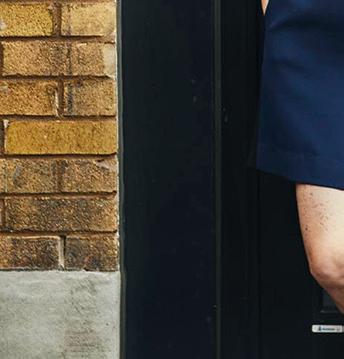
Convinced that “it’s the small details that make great kitchens,” the specialists at Cuisines Steam have been putting their stamp of excellence and quality on the culinary world of the home cook for more than 20 years. Their desire to boldly innovate, creating unique and sought-after concepts, prompted them to launch Coquo, their own collection of modular and freestanding kitchen furnishings, in 2017. — (cuisinesteam.ca)



Refined , attractive and functional, the finger-grip handle complements a minimalist style. The handle seems hidden at first glance, and integrates seamlessly and harmoniously with the kitchen cabinets, without visual distractions. — (cuisinesteam.ca)


With its antique bronze finish and clean-lined design, this Rubinet faucet brings a contemporary yet classic look to the kitchen. And it pairs beautifully with the Calacatta Viola marble, adding a contrasting touch of warmth. — ($950, rubinet.com)





For a bold , elegant touch in the kitchen, the Cuisines Steam team has a penchant for Calacatta Viola marble countertops. This natural stone gives a unique look with its pronounced veining and striking deep-purple colour palette. — (From $99 per square foot, ciot.com)



After making a splash in the European market, they are now arriving in our kitchens: Grooved cabinet fronts are available in a variety of styles and finishes, such as wood and lacquer, to add movement and depth. — (purecuisines.com)



Offering the best in Italian manufacturing on the market, PURE stays on top of the latest trends in products, quality, finishes and feasibility. The juxtaposition of natural materials and textures is the essence of their style, and in their kitchen designs they take a clear-eyed, rational approach, respecting the unique architectural aspects of each project. — (purecuisines.com)
For a nearly weightless appearance over the kitchen island, choose the Light ductless hood by Falmec. Thanks to its recirculating carbon/zeolite filter, no replacement filters are required. And its sleek lines, along with its linear LED lighting system, give it a clean, modern look. — (From $6,900, falmec.com/en-us)

This magnificent Bolgatanga lamp will turn heads when suspended over a kitchen island, peninsula or dinette. Made in Ghana, the lampshade is handwoven from a mix of recycled PET bottles and palm fibres. Instant kitchen makeover! — ($4,980, goodeeworld.com)
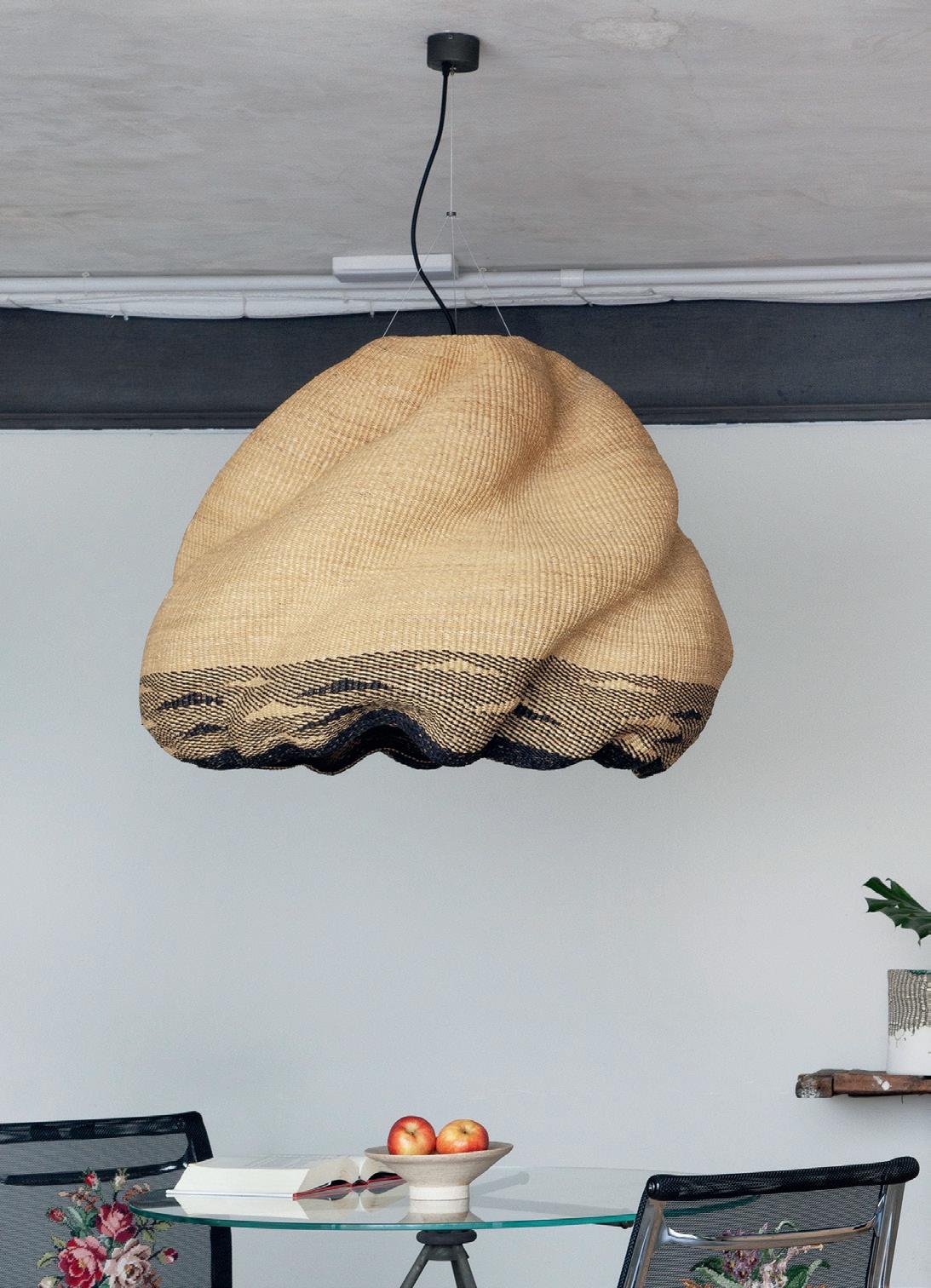
PURE-WOOL BLANKETS are back in a big way. For over half a century, tucked away in closets or blanket boxes, they were hardly seen. Folded in 12, they awaited a return to fashion. That moment has come—and, along with their mohair, alpaca and cashmere cousins, these collector items are as beautiful , cozy and timeless as ever.
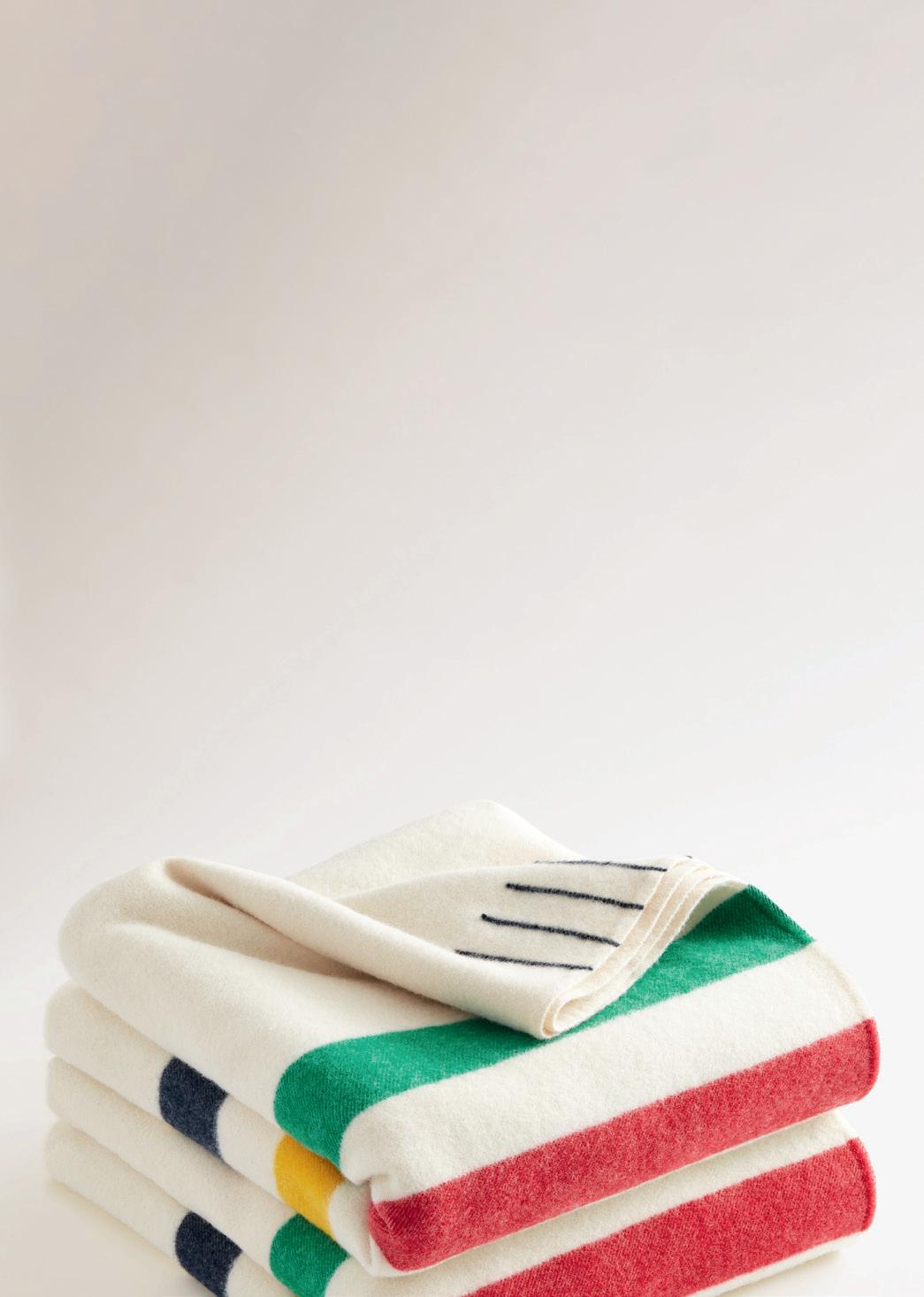 By Céline Tremblay — Adapted by Christopher Korchin
By Céline Tremblay — Adapted by Christopher Korchin
The Hudson’s Bay Company wool point blanket—which has been in continuous production since 1670—is an integral part of our history, for better or for worse. During the fur-trade era, at commercial trading posts across the country it was a common item among the goods exchanged with Indigenous Peoples. And in our harsh climate, it had multiple uses. Indeed, all it took was a needle and scissors to convert the blanket from its primary function as a bed cover and turn it into clothing, a horse saddle or even a sail for boats and sleds.

Made in England from local wool or wool imported from New Zealand, these blankets that are now regarded as icons of Canadian heritage underwent a major shrinking (or “fulling”) process—the pieces were one and a half times larger pre-treatment—which kept them from later hardening and prevented further shrinkage. The result is that well-preserved vintage examples can fetch serious sums of money.
Like many material goods from the fur-trade era, such blankets are also controversial. Well aware of the enduring impact of colonialism, the Hudson’s Bay Foundation—whose goal is to combat the injustices that persist among people of different origins and cultures—recognizes the company’s past, and it injected a million dollars into the launch of Oshki Wupoowane (The Blanket Fund), a project in collaboration with the Gord Downie & Chanie Wenjack Fund. One hundred percent of net proceeds now goes to supporting Indigenous cultural, artistic and educational activities. Since its creation, over $1.5 million has been raised. Also of note is the launch of the Hudson’s Bay Charter for Change, a commitment to invest $30 million over a period of 10 years to advance racial equity and the empowerment of Indigenous Peoples and people of colour in Canada. — (thebay.com)
TO FACILITATE TRANSACTIONS with Indigenous Peoples, a point system was developed for blankets to indicate their size and, therefore, their value. Four-point sizes (certified by four indigo lines woven into the edge of the blanket) were the largest (188 cm × 228 cm) and thickest—they were reserved for high-value trades, such as for beaver pelts. Mid-size blankets were traded for otter or muskrat pelts, while the smallest blankets (81 cm × 240 cm) were used for trades of low value, for instance for rabbit skins. —




An Ontario couple is all in for alpaca— it’s softer, warmer and lighter than sheep’s wool.
One day, Kyle Taylor received one of those magnificent Hudson’s Bay Company point blankets from a friend of his. He was thrilled, for sure. But, he says, “They really scratch!” Some people have no trouble cozying up to raw wool. Not Kyle.
In 2016, he went on a motorcycle trip with Stephanie, his spouse, in the Andes. In their expedition through Peru, they met alpaca ranchers and also weavers, who inspired them to gain both knowledge and expertise in the field. Their time away led to the creation of Blacksaw, their small company that makes alpaca wool blankets.


Their goal was to create timelessly beautiful pieces that respect where and how they were produced. With Zero Dye, their latest collection featuring 10 new models, they further their commitment by reducing their already small environmental footprint with even more sustainable practices.

The result is a line of simply designed classic blankets, environmentally friendly, hypoallergenic, 100 percent natural, as soft as cashmere and warmer than sheep’s wool. Made from hand-picked, highest-quality fibres, they are woven on both sides and therefore reversible. And their weight immediately signals that they are the real thing.












Fun fact: “Baby alpaca” is a somewhat confusing term. It relates to the diameter of the fibres taken from the animal, rather than its age. — (blacksaw.co)





[1] — Kyle Carson Taylor and Stephanie, founders of the Ontario company Blacksaw.
[2] — Peru is home to nearly 4 million alpacas—over 70 percent of their worldwide population.
[3] — Crosby Heirloom blanket woven from superfine alpaca and Peruvian cotton. Completely free of dyes. ($425, blacksaw.co)

Dance, Sleep & Sex. Thus reads the label on this classic pure baby-alpaca blanket from Magniberg. One of the great strengths of the Swedish company, which manufactures this collection of 12 tartans in Peru, is its bold colour combinations. The blankets are notable for their generous sizes (150 cm × 250 cm). ($580, magniberg.com)
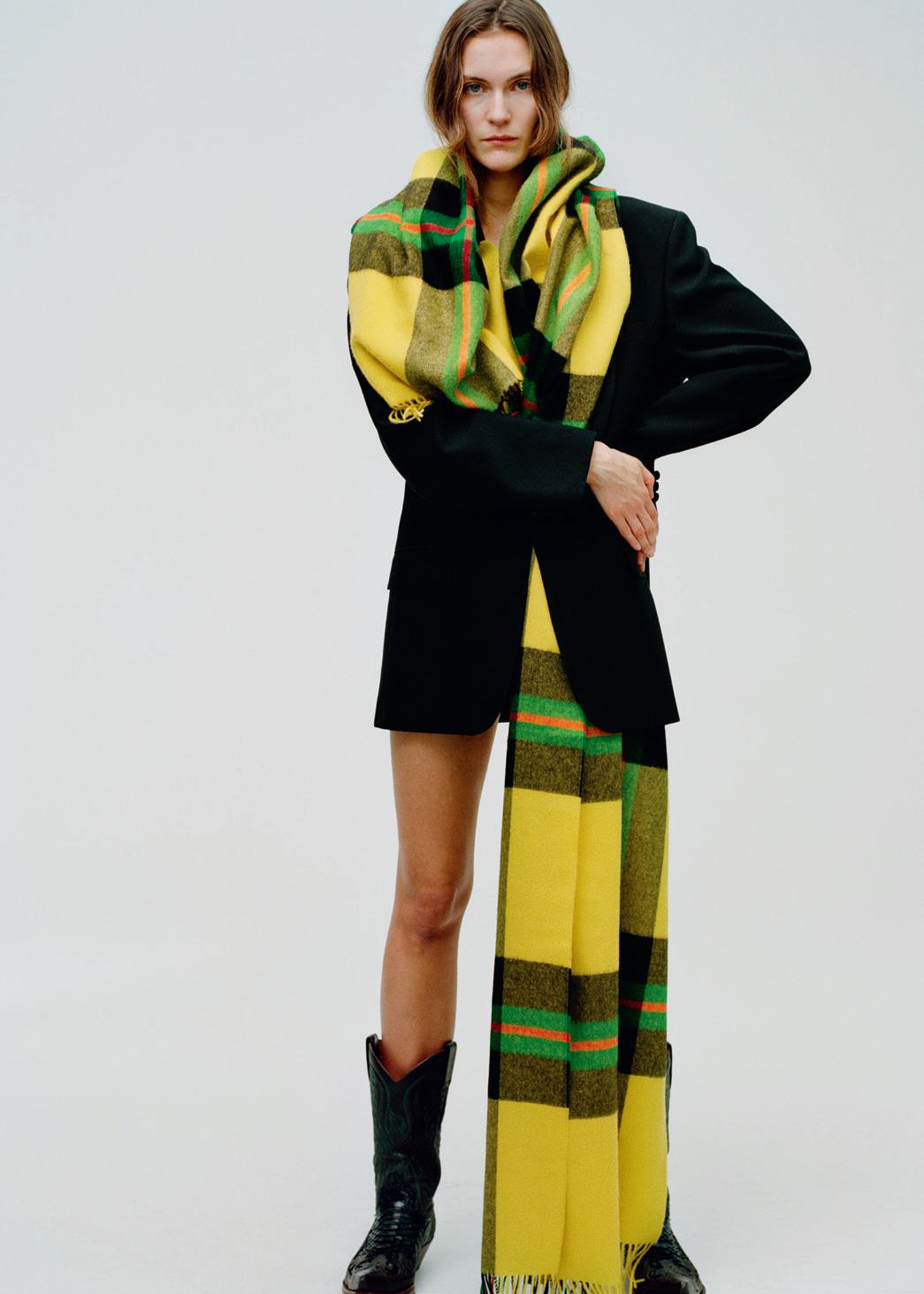
Cashmere, merino, alpaca, mohair…all these fleeces are golden, you just need to decide which one you can afford.
[1] — Mohair, which comes from angora goats, is pretty much the least talked-about fibre. But its texture is unrivalled and its beauty timeless, because when it’s woven it is practically run-proof. The New Zealand firm MasterWeave Textiles, true mohair experts, offers blanket throws in an array of desirable colours. Size: 185 cm x 130 cm. ($240, masterweavetextiles.com)




























[2] — On the Isle of Arran, off Scotland’s southwest coast, temperatures average 14°C at sea level in July. So it’s no surprise that cashmere is rather popular there. Just across the water is the town of Ayr, home to the workshops of Begg X Co, which produces classics that are easily recognizable for their slightly waffled texture. This kaleidoscopic cashmere plaid, the Arran Spangle Square, is one of the house’s finest works, and the definition of softness. ($1,700, beggxco.com)















[3] — In Bloomfield, on Prince Edward Island, MacAusland’s Woollen Mills has been producing 100 percent virgin Canadian wool blankets since 1932. This family business hasn’t changed its production methods since day one, and chooses to not felt its weaves in order to keep them light. ($75–$145, macauslandswoollenmills.com, loregeneralstore.com)



An MCM Classic Reborn (PAGE 54) In a quiet North Vancouver enclave, a modernized mid-century retreat has gained new life in its leafy surroundings Atta in Wonderland (PAGE 68) An Ontario collector has turned a typical 19th-century farm into a showcase for treasures from the past — Time Management (PAGE 82) Using a coherent approach and a dash of intuition, Toronto designer Ashley Botten maintained the spirit of an interior from a bygone era while remodelling it for modern times — The Test of Time (PAGE 94) In a project commissioned to Montreal’s La Shed, a typical NDG home regains its youthful splendour without selling its soul
Nestled in the quiet North Vancouver enclave of Edgemont Village, a refreshed mid-century modern retreat has gained new life. Architecture firm OLSON KUNDIG and interior designer ERICA COLPITTS are behind the sparkling transformation.
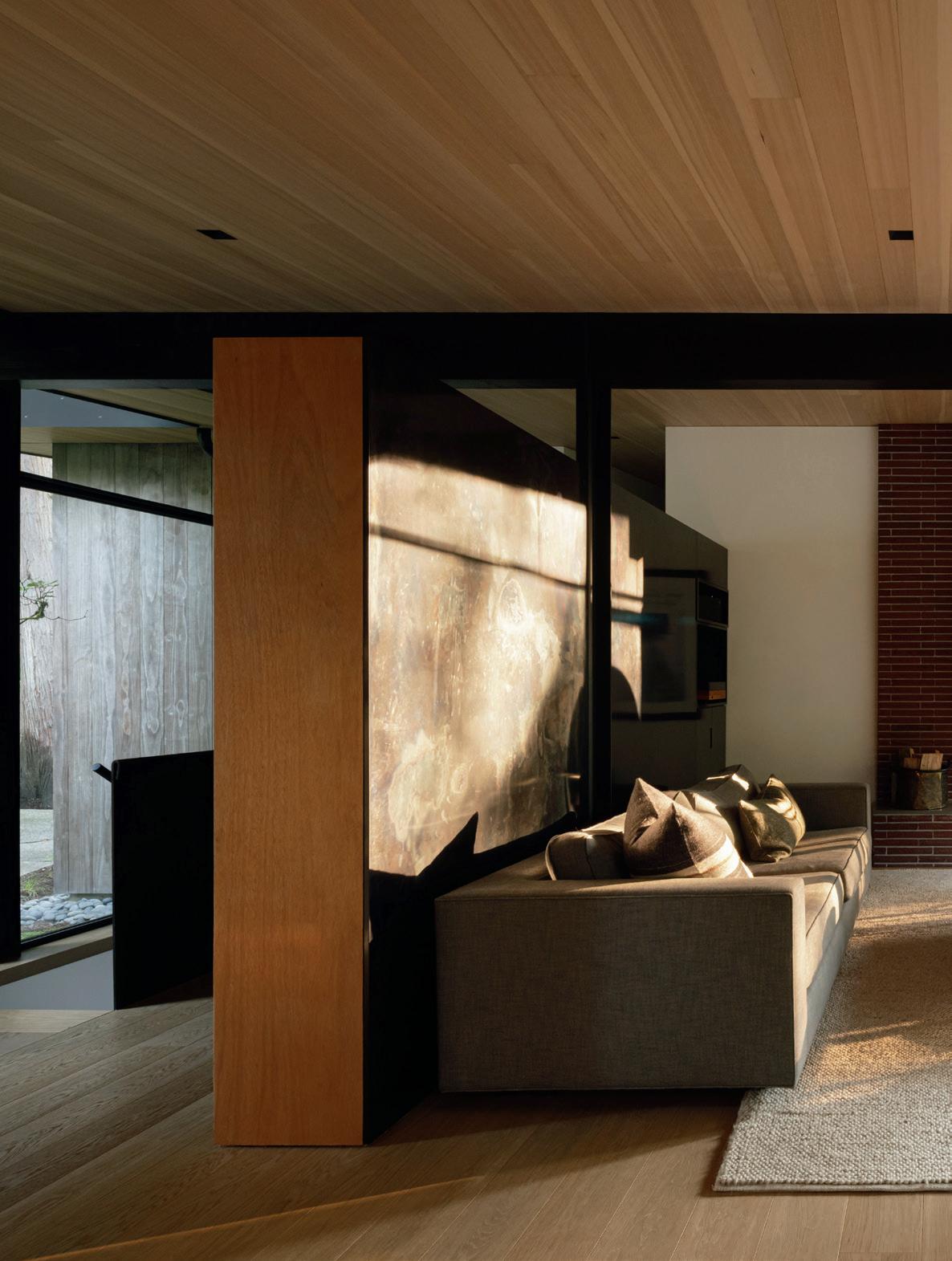 By Marouchka Franjulien —
Adapted by Christopher Korchin — Photographs by Ema Peter
By Marouchka Franjulien —
Adapted by Christopher Korchin — Photographs by Ema Peter
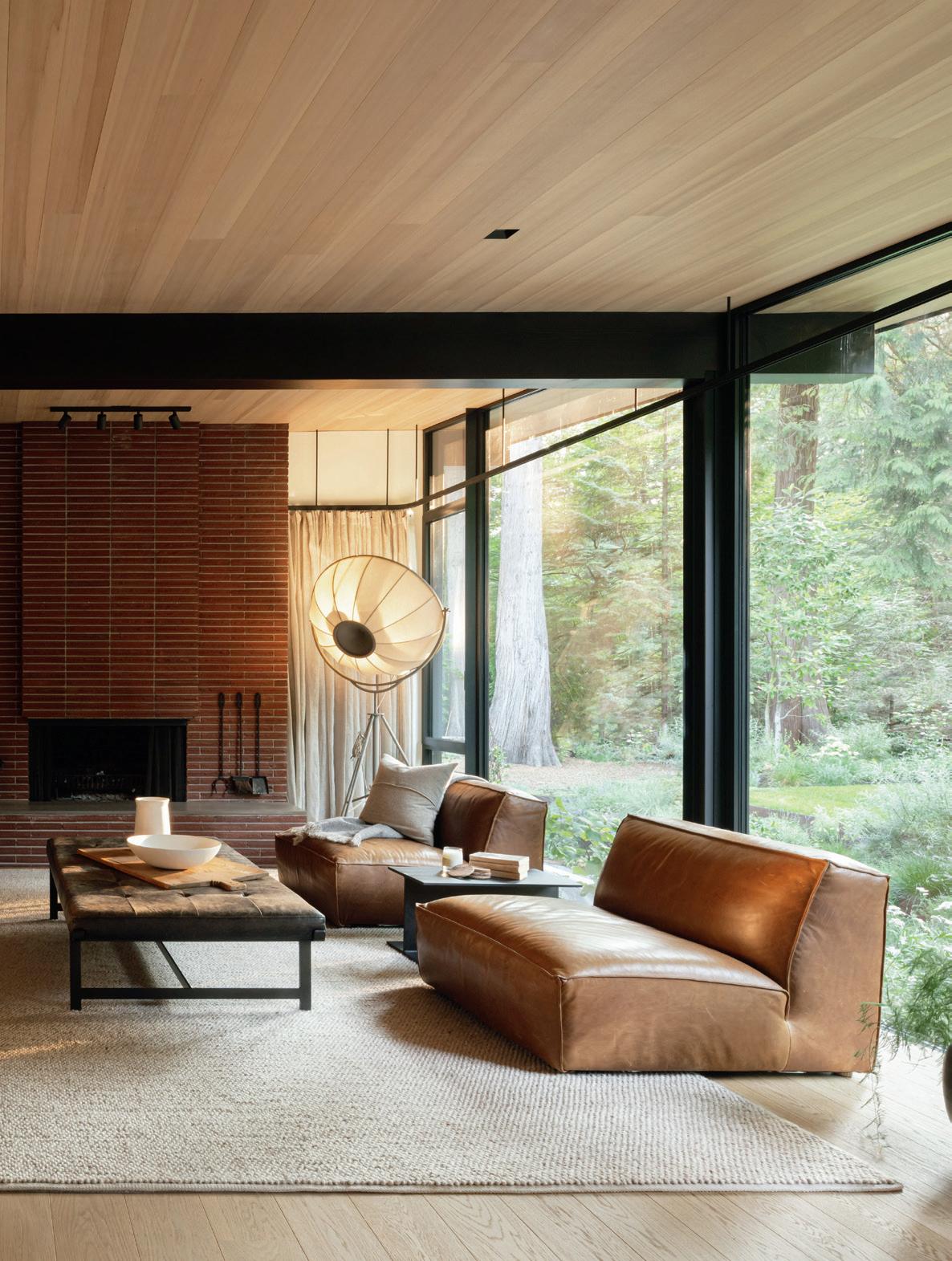
Hidden behind an impressive stand of cedars, maples and azaleas that practically glow in springtime, the home seems to melt into the landscape. But as you pass by, you can still see the bookcase, an intrinsic part of the house that defies time. It’s hard to imagine that out back, the garden gives way to a wooded area that runs down the slope of a ravine to a small stream. But here, nature is never far away: The North Shore Mountains, whose white peaks stand against the blue sky, are just kilometres off in the distance, even though downtown Vancouver is only 20 minutes away by car. Edgemont Village is definitely not lacking in charm or natural features, especially when you’ve become accustomed to the frenetic pace of New York City.
That’s the case of the owners—he’s Canadian, she’s Australian—who now live in this striking abode with their two children, a boy and girl aged 10 and 6, respectively. A few years ago, when they purchased this mid-century modern home, it was stuck in the 1950s. They needed to find an architectural firm that could preserve its history but also find a way to give it a modern touch and make the space more adapted to family life. The collaboration with Olson Kundig, from 2017 to 2020, was the answer. “One of my big agendas in design is to repurpose existing buildings rather than tearing them down,” says Tom Kundig, principal owner and co-founder, with Jim Olson, of the internationally renowned architecture firm. “The clients’ desire to respect that character was totally aligned with that, and I knew it would be a great project.”
Meanwhile, designer Erica Colpitts had come on board. Previously, her namesake studio in Vancouver was known for restaurant makeovers, but the owners of the house—friends of friends—needed assistance to explore various materials and local shops. Her helping hand soon became a full-on collaboration. The clients were very involved throughout the process—she with the aesthetics and he on the functional side—but Colpitts was there to ensure the clients got what they wanted while sticking to the industrial vision of Olson Kundig. Inspiration came from Australian and English country homes to create a decor that was simultaneously romantic, melancholy and serene, with an eye to nature. “We made sure that nothing would be a distraction from the forest,” says Colpitts. In every living area, the colour palette is subtle, the materials are natural and the furniture sits low, ensuring unobstructed views of the landscape beyond the almost entirely windowed rear of the building.
To maintain the heritage of the home, it was essential to keep the angular line of the roof, so typical of mid-century architecture, as well as the wonderful rust-red brick chimney, a central feature in the living room. And despite its sorry state, the clients insisted on keeping the bookcase that quietly separates the sitting room from the entranceway. So it was duly sanded,
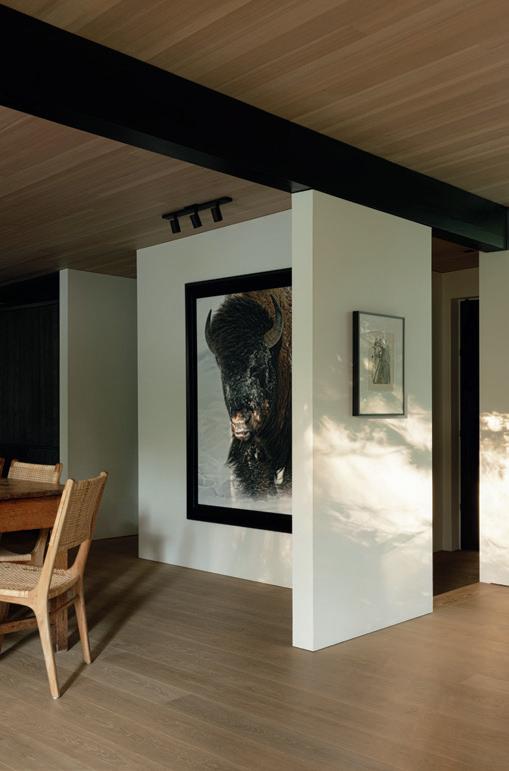

“By maximizing the efficiency of the spaces, we created a natural flow from one to the other.”
— Tom Kundig
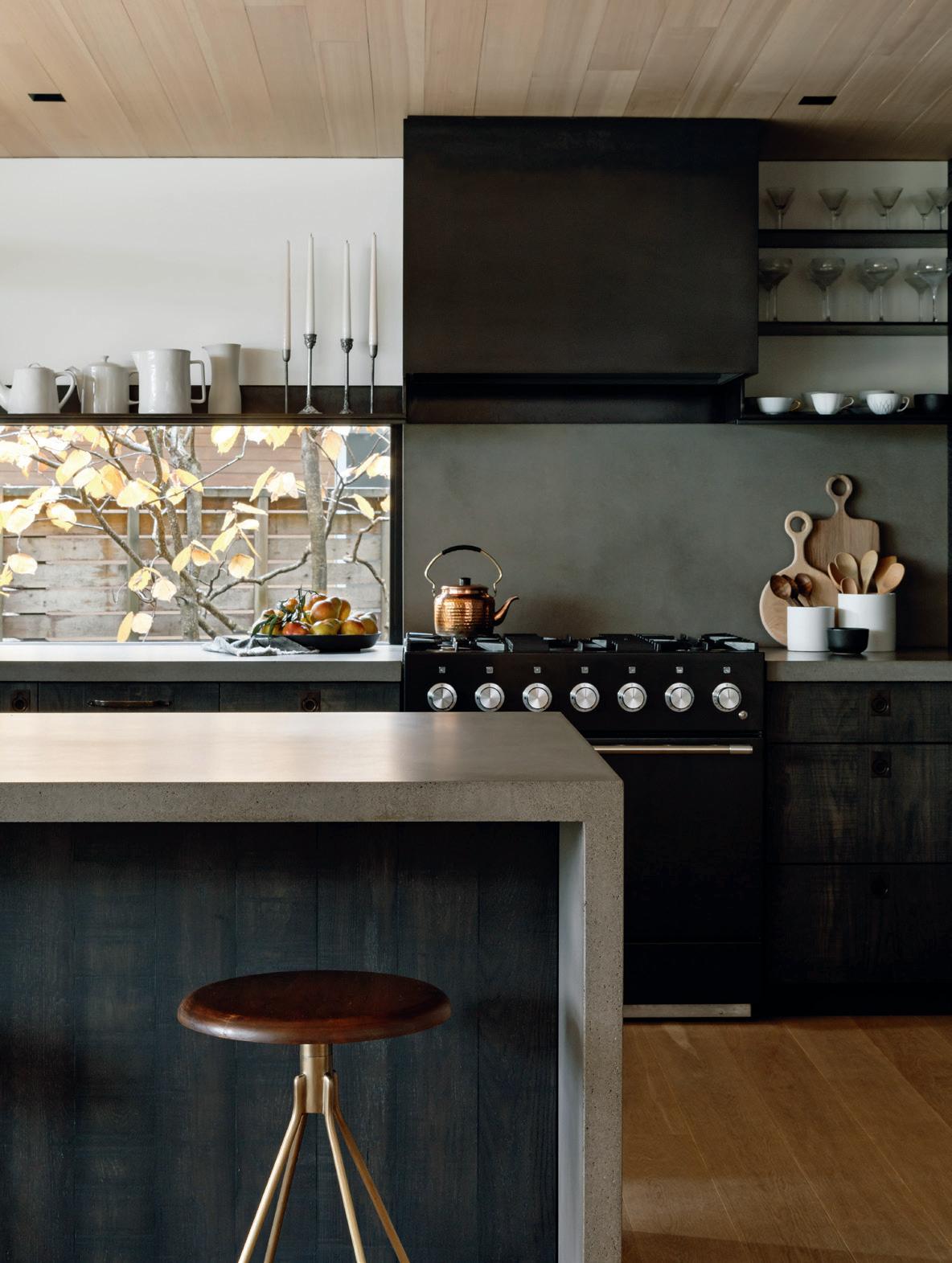
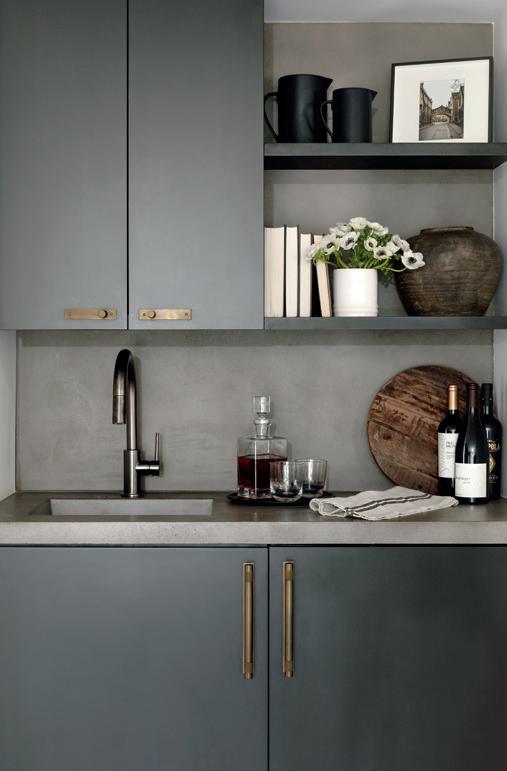
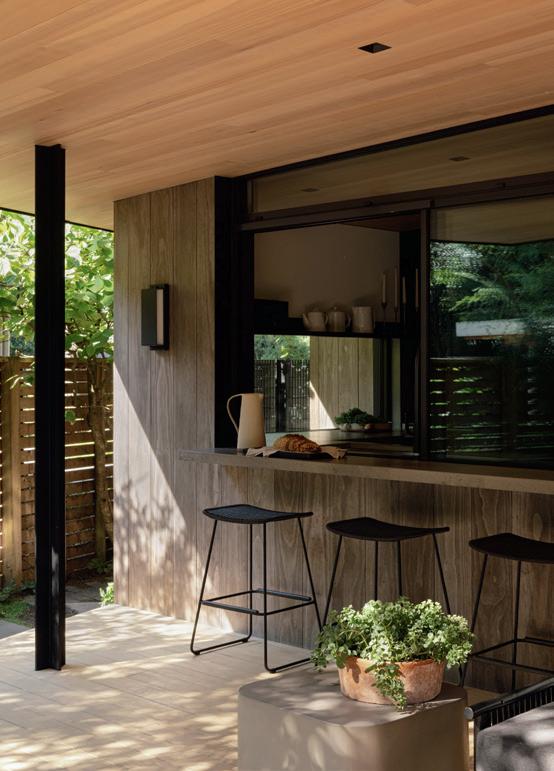




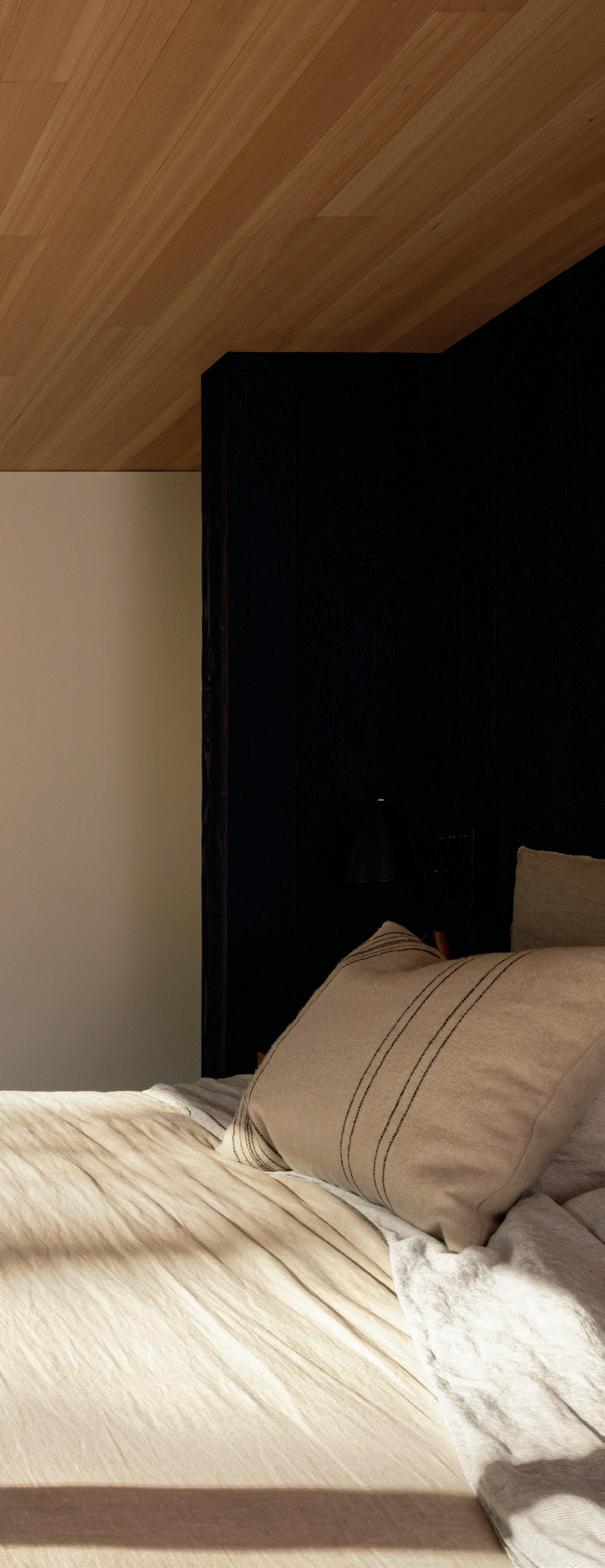

In the bathroom, the choice of materials creates a successful dramatic effect, from the Brodware stone sink and metal faucet (brodware.com) to the limestone wall tiles from Adera Natural Stone Supply (aderastone.com) and the white-oak barn-style door by Stilewood International Door and Window (stilewood. com), accented by a handle from the Tom Kundig collection for 12th Avenue Iron (12thavenueiron.com).
repaired and beautified. As for the George Nelson light—an authentic example—it belonged to the former owners, who were the original and only residents at this address. When Colpitts first saw the iconic spherical lamp in the vestibule, she couldn’t believe her eyes. Now, after having been meticulously rewired and restored, the Saucer hovers above a well-used dining table that is unafraid of stains or colouring sessions. That was a priority for the couple, generous hosts who would never want to prevent their guests or their kids from enjoying themselves.
It all required great creativity. “Space was a major challenge throughout the project,” says Tom Kundig who, along with his team, tried to maximize every square centimetre without making the rooms seem cramped. The kitchen was enlarged, walls were removed and an annex was added to the back of the house, which also allowed the builders to increase the size of the main bedroom. The owners wanted a garage, but Olson Kundig proposed an open carport—a nod to mid-century modern architecture, and more visually engaging.
Colpitts has fond memories of the day when she clinked glasses of bubbly with her Australian client to celebrate the arrival of the tiles for the main bathroom. “The homeowner kept seeing a photograph on Pinterest of these beautiful handmade tiles,” says the interior designer who, after checking out multiple local options, made the difficult choice to go back to the source. That happened to be a hotel in Portugal. A phone call later, the company—which had acquired the full output of a local artisan—was ready to send her its surplus supply. Happily, there was enough for the job.
The interior designer, who put the final touches on the decor in the spring of 2021, has struck up a friendship with her clients and gets to enjoy the fruits of her labour from time to time. “More often than not, the homeowners have a fire burning, classical music playing, the fresh pot of tea has just been steeped. It just feels lovely to be there,” she says. Being a good host isn’t something you learn, but in that regard, the owners don’t need anyone’s help. — (olsonkundig.com) (ericacolpitts.ca)
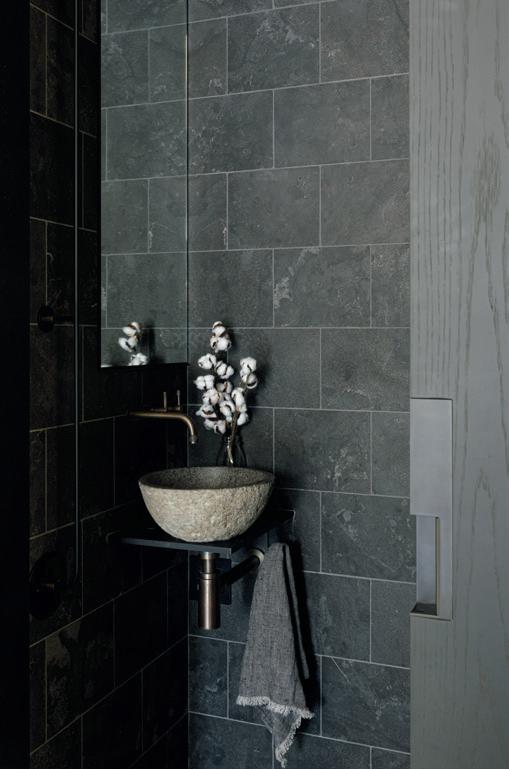
In the main bedroom, the wall—covered in wood panels burnt using the Japanese technique of yakisugi—creates instant atmosphere. To maximize the space, Erica Colpitts designed the night table, manufactured by Nicholas Purcell (nicholaspurcell. com), as well as the linen headboard, built by Cloth Studio (clothstudio.ca). A few key elements complete the decor, among them a wall sconce from Crate & Barrel (crateandbarrel.com), a striped cushion from CF Interiors (cfinteriors.ca) and a ceramic pitcher by Elise Dufour (thestylewell.com).

“The home is a juxtaposition of all good things: It is dramatic and serene, rustic and refined, industrial and romantic, exquisite and comfortable.”
— Erica Colpitts
The built-in, mahogany-veneer bookcase was carefully restored by Intempo Interiors (intempointeriors.com), under the trained eye of Erica Colpitts. Olson Kundig added details in bronze and steel, a material that was also selected to create the fixture above the staircase, which features RH lamps (rh.com).
Opposite page — The hemlock spruce ceiling and white-oak flooring required several rounds of staining to bring out the character of the two woods, in perfect balance.

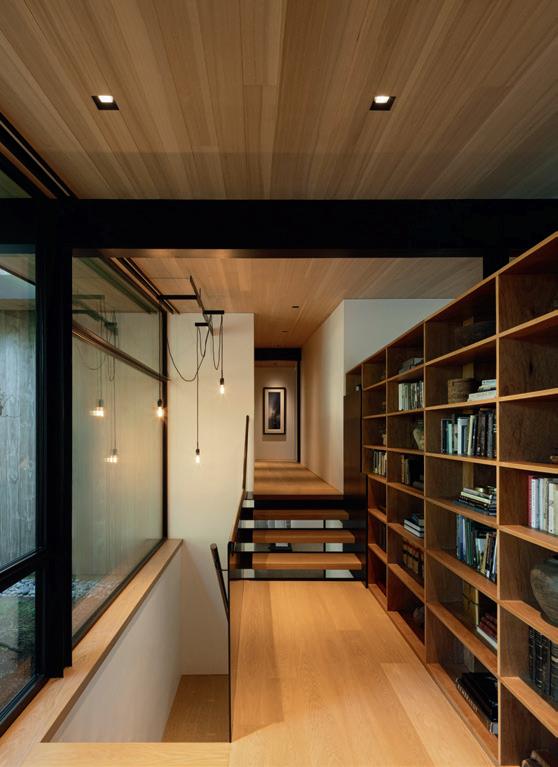
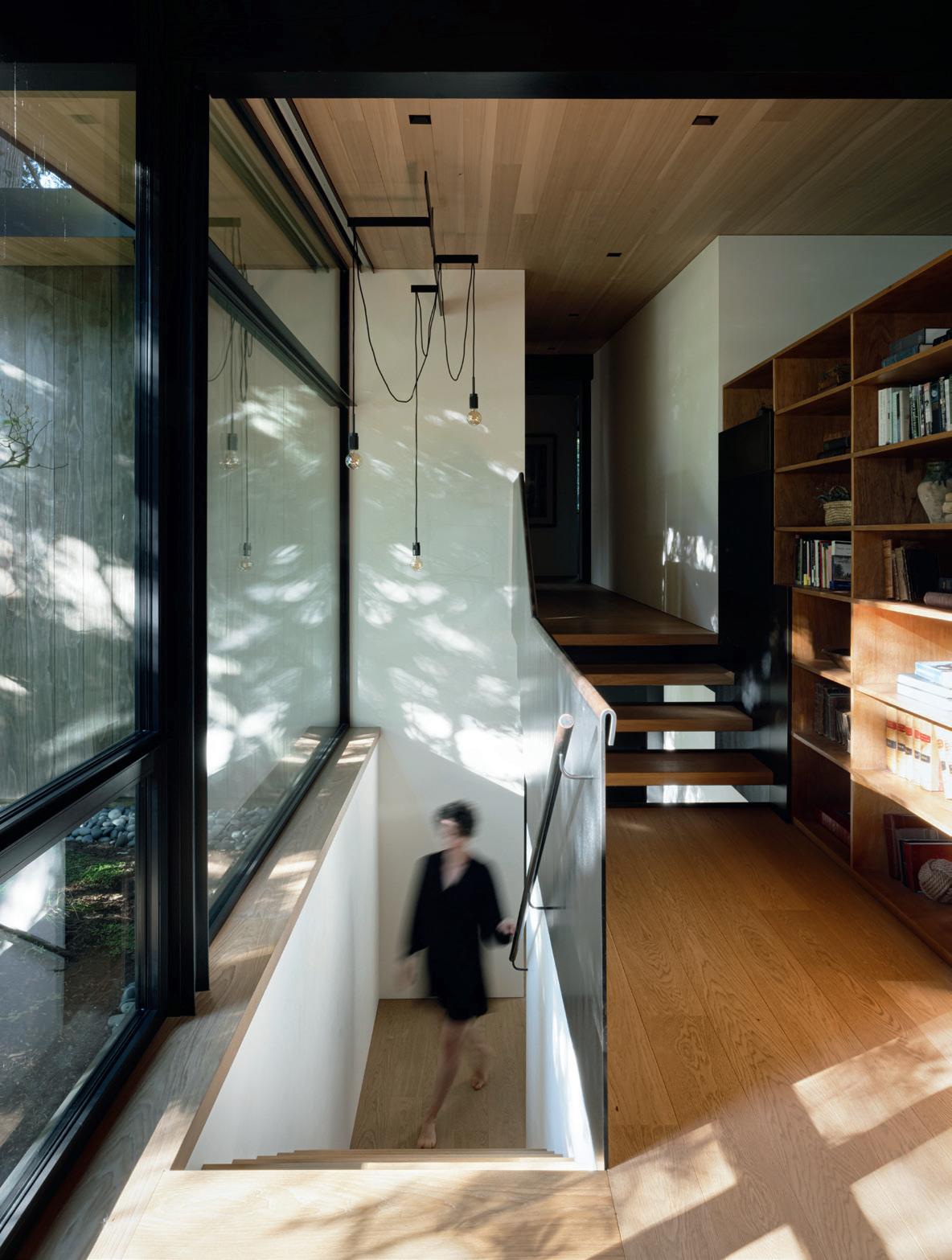
ATTA-UL GHAFFAR , a collector of beautiful things, is the proud owner of a small farm in Breslau, Ontario , dating to the 1840s. The simple, plain decor of the old farmhouse provides the perfect showcase for his treasures from a bygone era.

 By Marouchka Franjulien — Adapted by Christopher Korchin —
By Marouchka Franjulien — Adapted by Christopher Korchin —

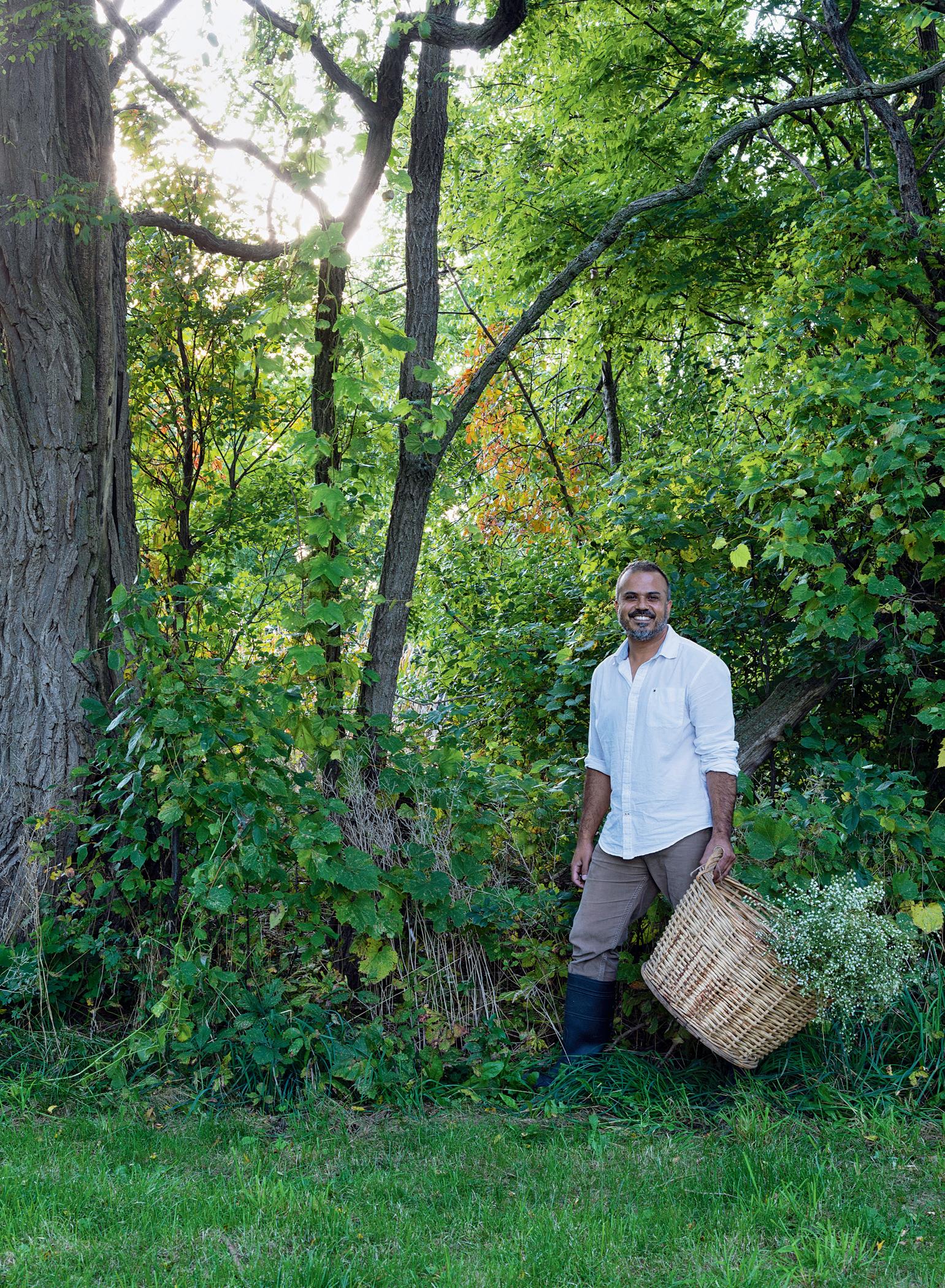 Opposite page — The former root cellar today serves as a backdrop for displaying clay pots that have stood the test of time.
Atta-Ul Ghaffar savours every minute he spends on the property, close to nature.
Opposite page — The former root cellar today serves as a backdrop for displaying clay pots that have stood the test of time.
Atta-Ul Ghaffar savours every minute he spends on the property, close to nature.
On a typical cold Canadian winter day in February 2021, the dry, freezing air cuts like a knife. The thermometer reads close to -30°C and the polar chill envelops everything in its path. Atta-Ul Ghaffar had to plug in the block heater on his SUV before hitting the snow-covered road between the city of Cambridge, Ontario, and Breslau, a small village surrounded by farmland. The previous evening, this computer engineer and avid antiques collector had received a message from a friend alerting him to a clearing-out sale at a farmhouse, which now comes into view at the end of a driveway. The former owner, who called this place home for almost 50 years, had plenty of time to collect souvenirs, and Atta is hoping to find a few gems for his online boutique Objekts (objekts.ca), which he curates in his spare time.
When he arrives on-site around 10 a.m., quite a few items remain, although the most prized


ones have already been auctioned off. “I was pretty much one of the last people to be contacted to come take a look at this house,” says Atta, who nonetheless managed to acquire a sofa from the 1820s that day along with about a dozen boxes filled with ironstone china pottery. That could have been the end of the story, but this collector—who honed his skills and scouting instincts during a decade of rummaging through flea markets on the Old Continent, where he frequently travelled for work—decided to take a peek at what lay behind the old wallpaper that lined the rooms, which over the years had started to peel off in the corners. “I saw this beautiful green plaster,” recalls Atta, “and right away I could think that the whole house […] would have so much potential.”
The home sits on a one-acre lot, and despite the thick layer of snow, Atta, along with his friend, decided to brave the cold and explore the rest
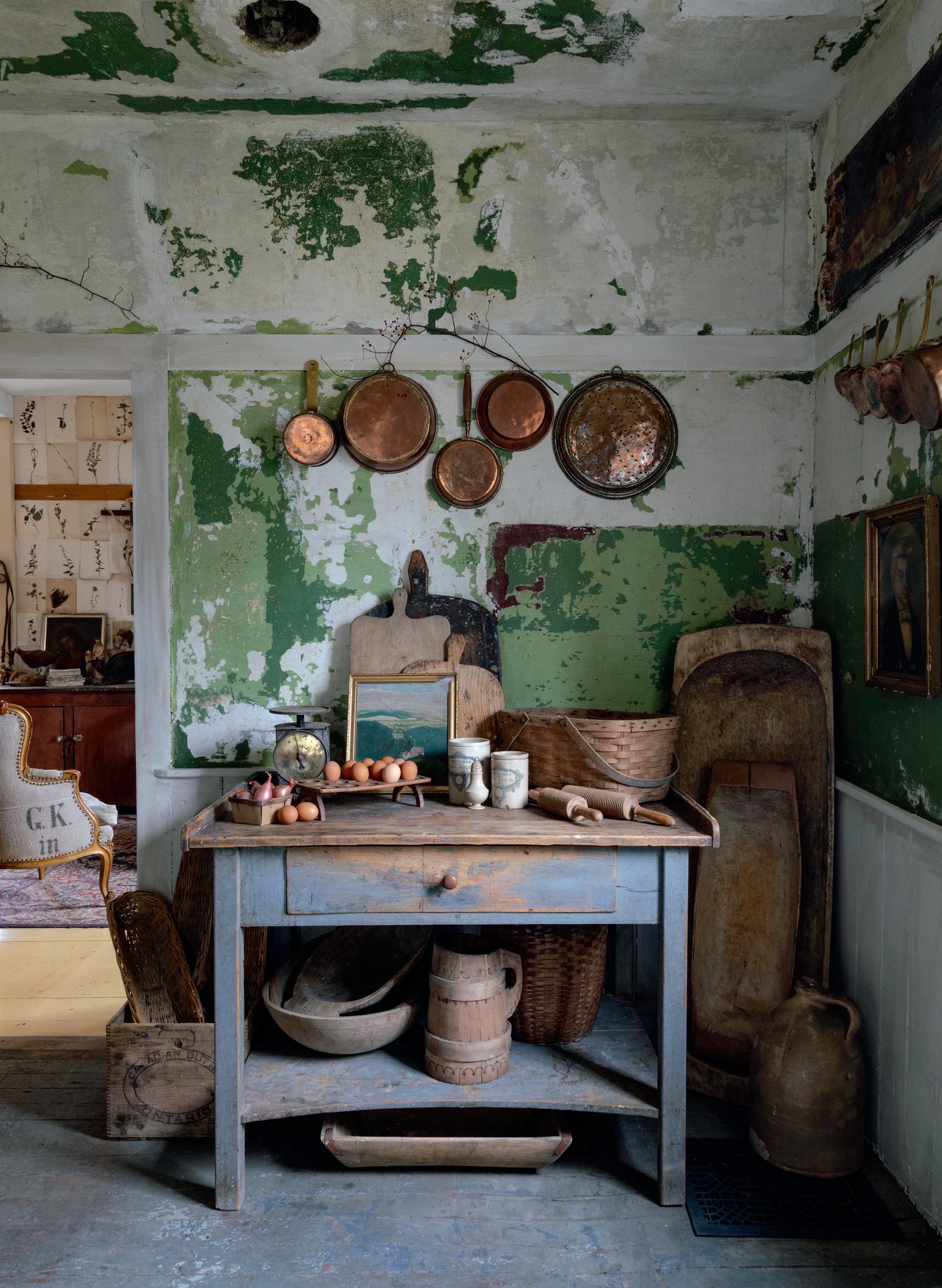 Copper pots and pans hang above a wooden worktable whose flecked paint echoes that of the kitchen’s uncovered walls.
Copper pots and pans hang above a wooden worktable whose flecked paint echoes that of the kitchen’s uncovered walls.
of the property, which includes a root cellar, a summer kitchen and two barns, one of them made of stone and featuring a wonderful cathedral ceiling. “I looked at that ceiling, and that was a moment where yes [I said to myself], I want this farmhouse,” he explains. Actually, he had been looking for some time for a place where he could display his many finds, which had been steadily accumulating in his garage, his basement and even elsewhere in his home. The unique appeal of the old farmhouse, which could also serve as a second home for his family, prompted him to take the plunge.
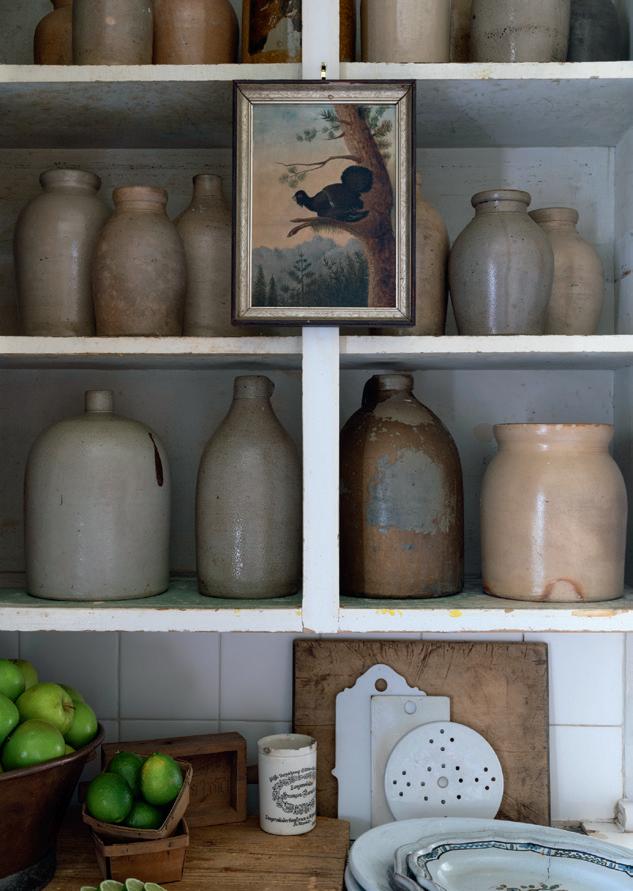
For now, Atta has no regrets. “I will be honest, in the beginning I thought the ceiling would fall on my head and the floor would break, but this house is very solid.” True enough, the walls, which are still doing their job after almost 200 years, have withstood the test of time, and now,
freed of the wallpaper that was suffocating them, they once again evoke the olden days. Luckily, the linen-based wallpaper came off easily—all it took was a few hours’ work to uncover the plaster surfaces of the partitions, which Atta wanted to preserve at all costs. But the plywood flooring, held down by nails, was a whole other matter. “My four daughters, my wife and I, we would sit for hours to take them out,” recalls Atta, who continues to find random nails here and there from time to time, despite all their efforts. These forgotten traces are part of the home’s history, just like the bumps and gaps in the original flooring, which was hidden under carpeting. In front of the place where the oven once sat, where one can imagine generations of former owners doing their cooking, day after day, year after year, the floor is slightly sunken, a testament to the passage of time. The same goes for the stairs, worn down

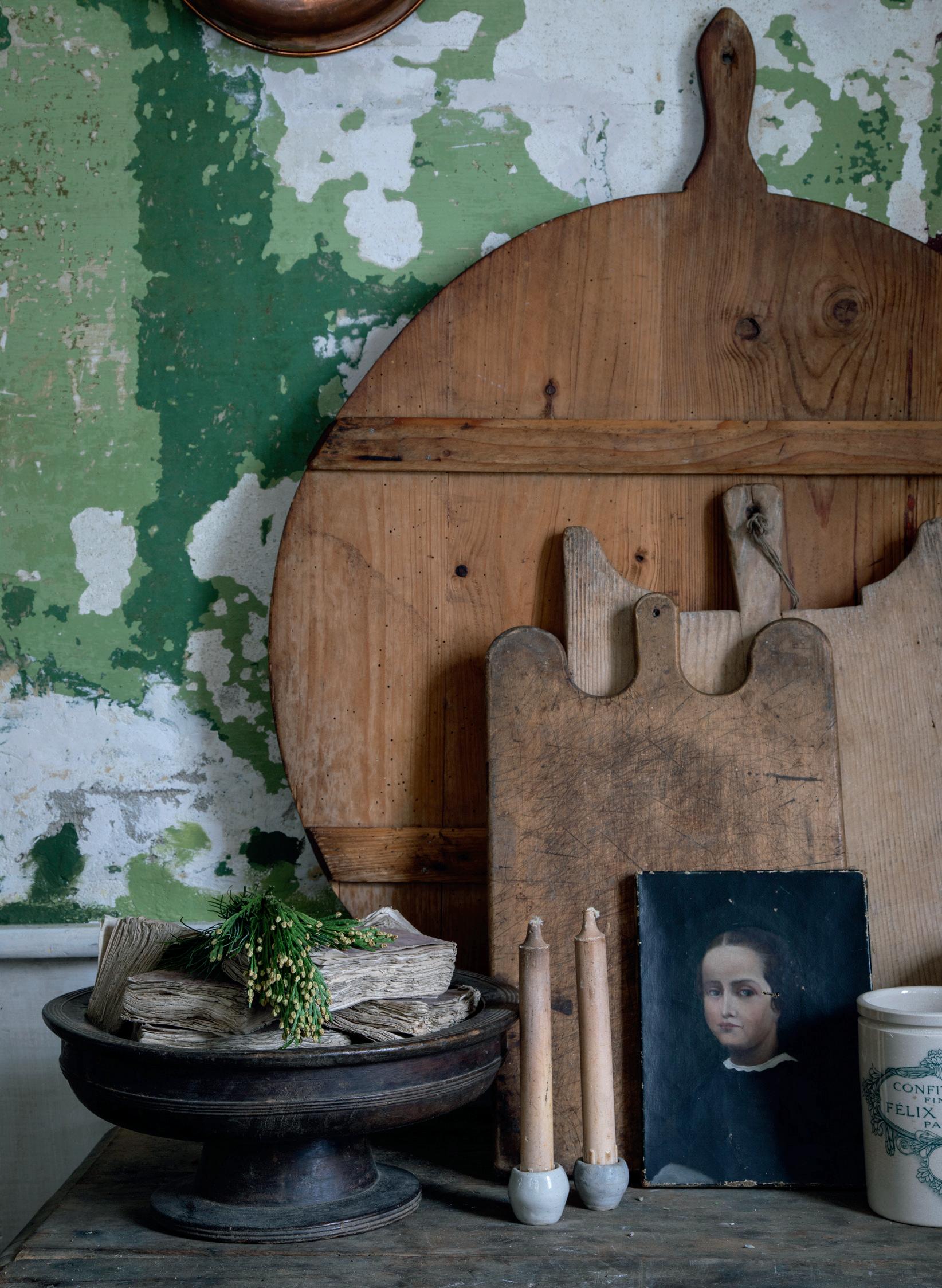 Among a collection of disparate objects, a large German cake board stands out.
Among a collection of disparate objects, a large German cake board stands out.
 A table and wooden chairs, their paint partially stripped, find new life.
Opposite page — Perched above a large mortar, a stuffed ram’s head guards the entrance to the summer kitchen.
A table and wooden chairs, their paint partially stripped, find new life.
Opposite page — Perched above a large mortar, a stuffed ram’s head guards the entrance to the summer kitchen.


Opposite page — A living room wall displays sheets of plant specimens from a herbarium, one of Atta’s favourite finds, from a German flea market.
This wall, relieved of the wallpaper that once covered it, contrasts with a pair of oil paintings and the famous 1820s sofa, reupholstered using grain sacks.

in the middle from years of friction. But the farm is once again buzzing with life, and Atta and his family are the ones now nurturing its soul. “In the beginning, I wanted to change many things in this house. The yellow paint in one room, leaning stairs, uneven floors and the wallpaper in the master bedroom. But as time passed, I began to love this house despite all its flaws and imperfections,” says the collector, who talks about his property as if it were a person that there’s no point in trying to change. Which is a good thing.
The biggest effort of all went into the kitchen, with a budget of only a few hundred dollars but a large dose of creativity. All in all, the makeover—which was fairly minimal—lasted about a year and a half, ending last fall. Meanwhile, Atta has taken a break from his job to concentrate on his antiques boutique and his new second home, acquired right in the middle of
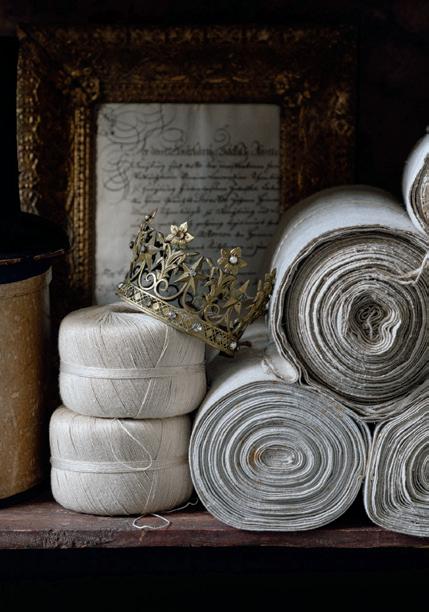
the COVID-19 pandemic. “Our family needed a good distraction. This house kept us focused and together in that uncertain time,” he says. In this pastoral setting, the birds sing year-round and the tranquil atmosphere seems to put time on hold. On an autumn evening, the Ghaffar family—who have perfected the art of s’mores-making—can be found gathered around a fire, happily roasting marshmallows on the ends of sticks. Simple pleasures, in perfectly simple surroundings. — (objekts.ca)

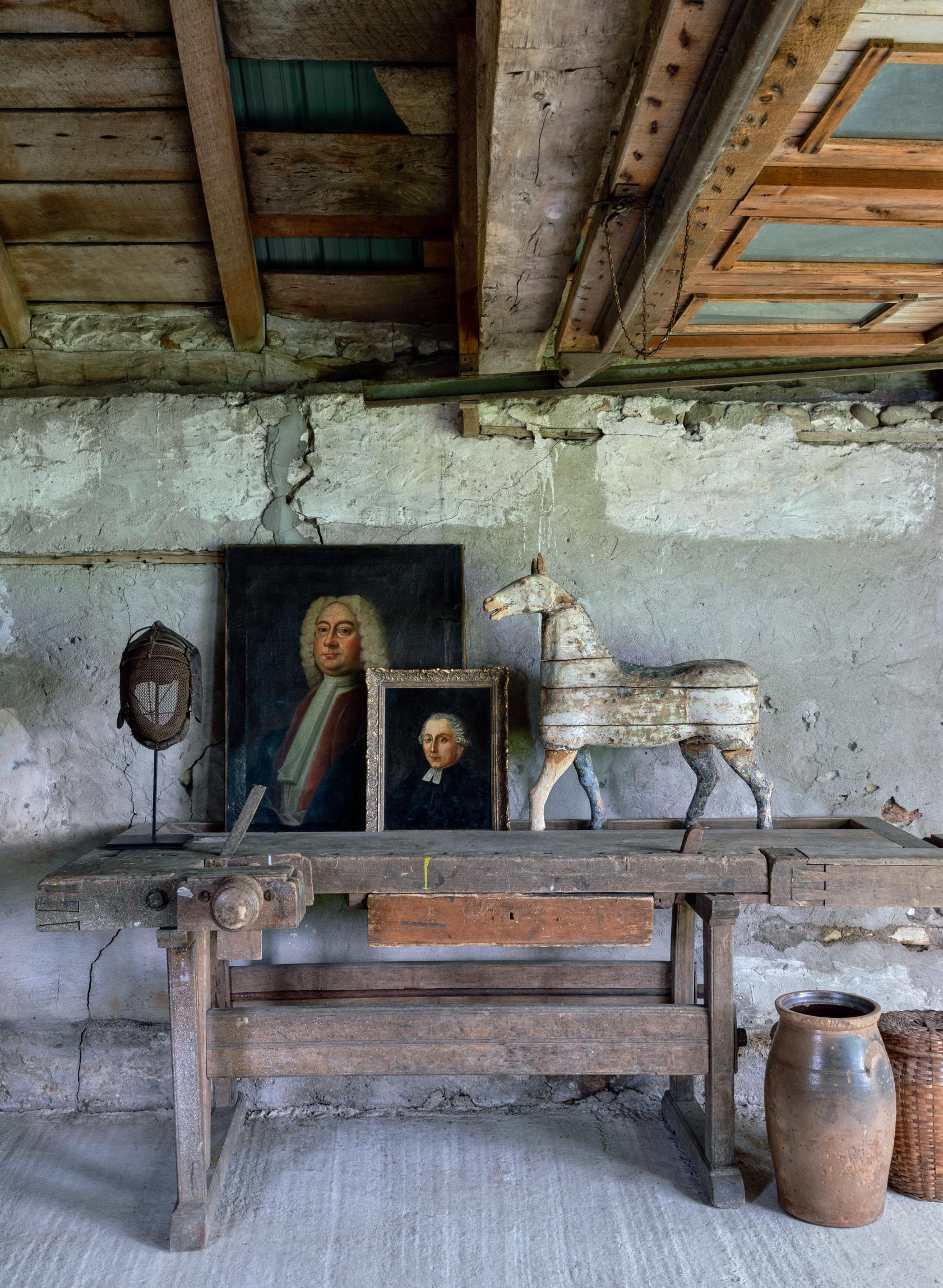 A wooden workbench complements the rustic charm of the stone barn’s cathedral ceiling.
A wooden workbench complements the rustic charm of the stone barn’s cathedral ceiling.
Hanging on the wall beside a bed, authentic carpet beaters lend a distinct rustic charm.
Opposite page — A large 19th-century portrait stands out against the wallpaper in the main bedroom, which Atta decided to keep.

“Just like in any relationship, you need to accept the person’s flaws and imperfections rather than trying to change them. We learned to love this house with its original features.”

Giving a home interior from a bygone era new life in the 21st century was a technical, temporal, financial and creative challenge, but Toronto designer ASHLEY BOTTEN was up to the task. The key? Experience and respect, but also intuition.
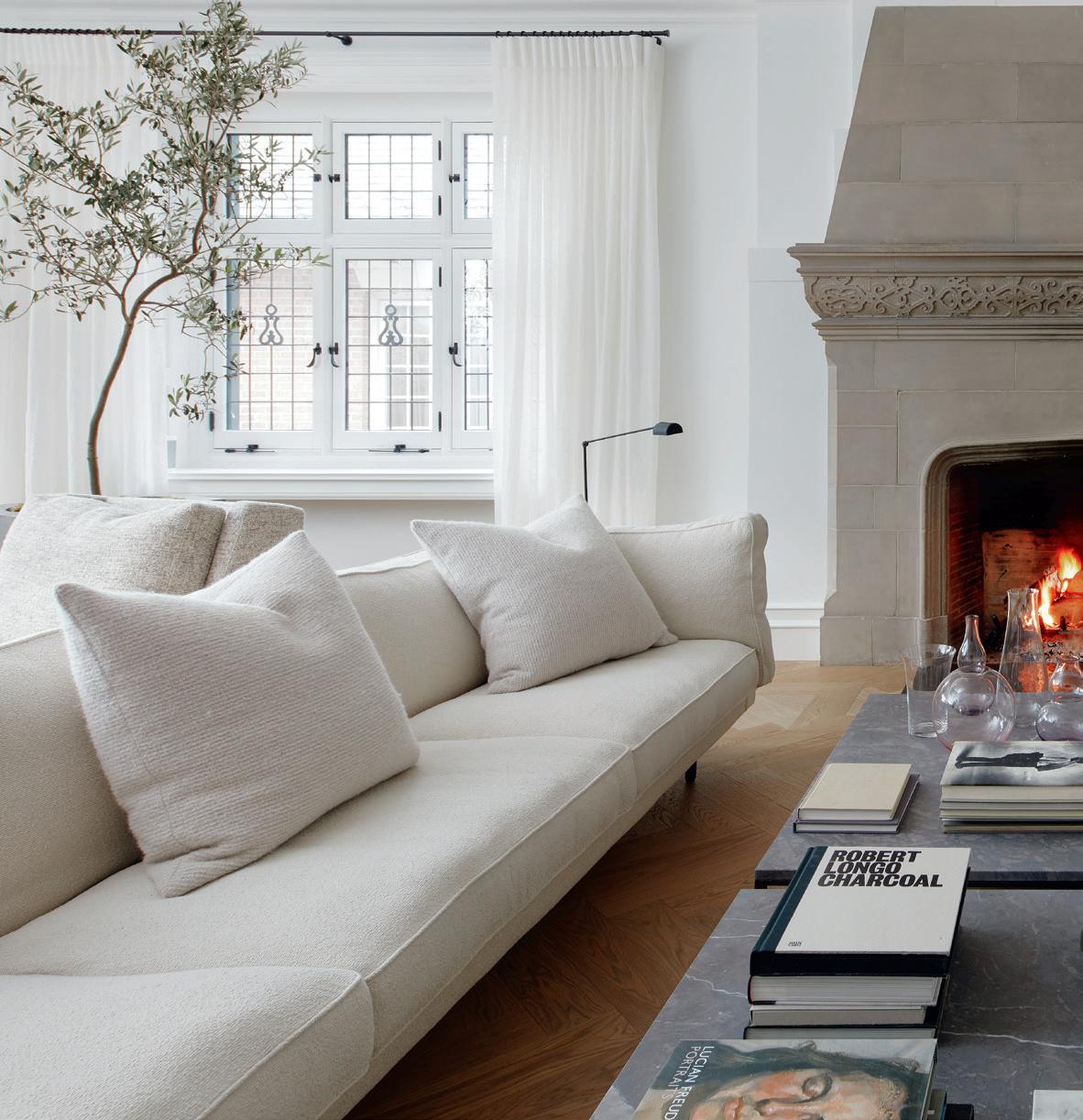 By Céline Tremblay — Adapted by Christopher Korchin — Photographs by Colin Faulkner
By Céline Tremblay — Adapted by Christopher Korchin — Photographs by Colin Faulkner




In the spacious living room, which served as a ballroom in the days of owner-architect E.J. Lennox, the splendid ceiling precludes any need for ornamentation. Two long, streamlined Square 16 sofas by De Padova (depadova.com), facing one another around the stone fireplace, accentuate the room’s symmetry, an impression further reinforced by two parallel custom-made coffee tables. In the background, at right, a candelabra brought back from Europe.

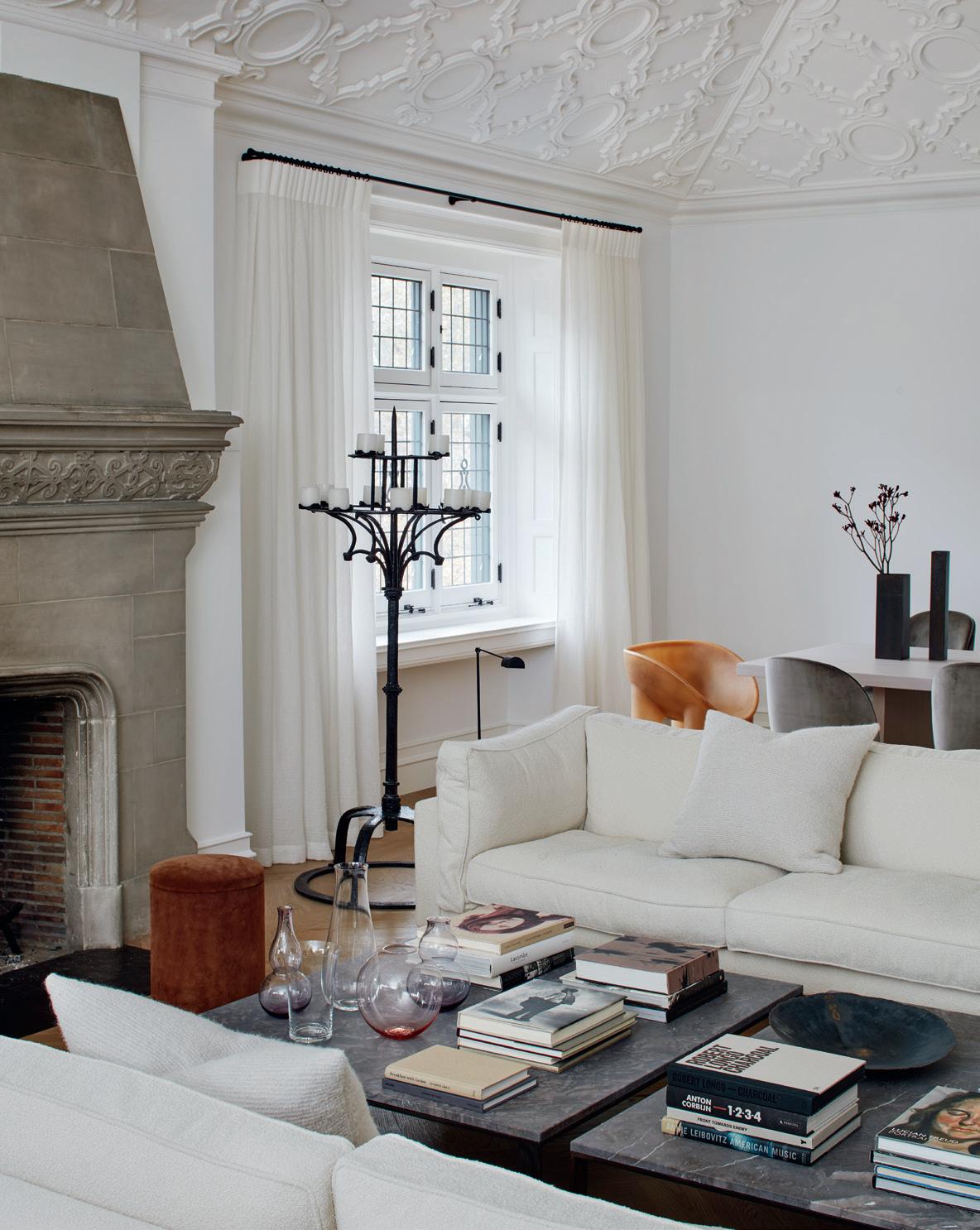
Opposite page — At the back of the living room, Danish Beetle chairs by GamFratesi (gamfratesi.com) are grouped around the dining room table. The rectangular vases are from Ashley Botten’s own boutique (ashleybottendesign.com).
An icon of the last decade: the moulded fibreglass Roly-Poly chair, a tribute to designer Faye Toogood’s experience of motherhood (t-o-o-g-o-o-d.com). Beside it sits an apple box created by Ashley Botten’s design studio (ashleybottendesign.com).
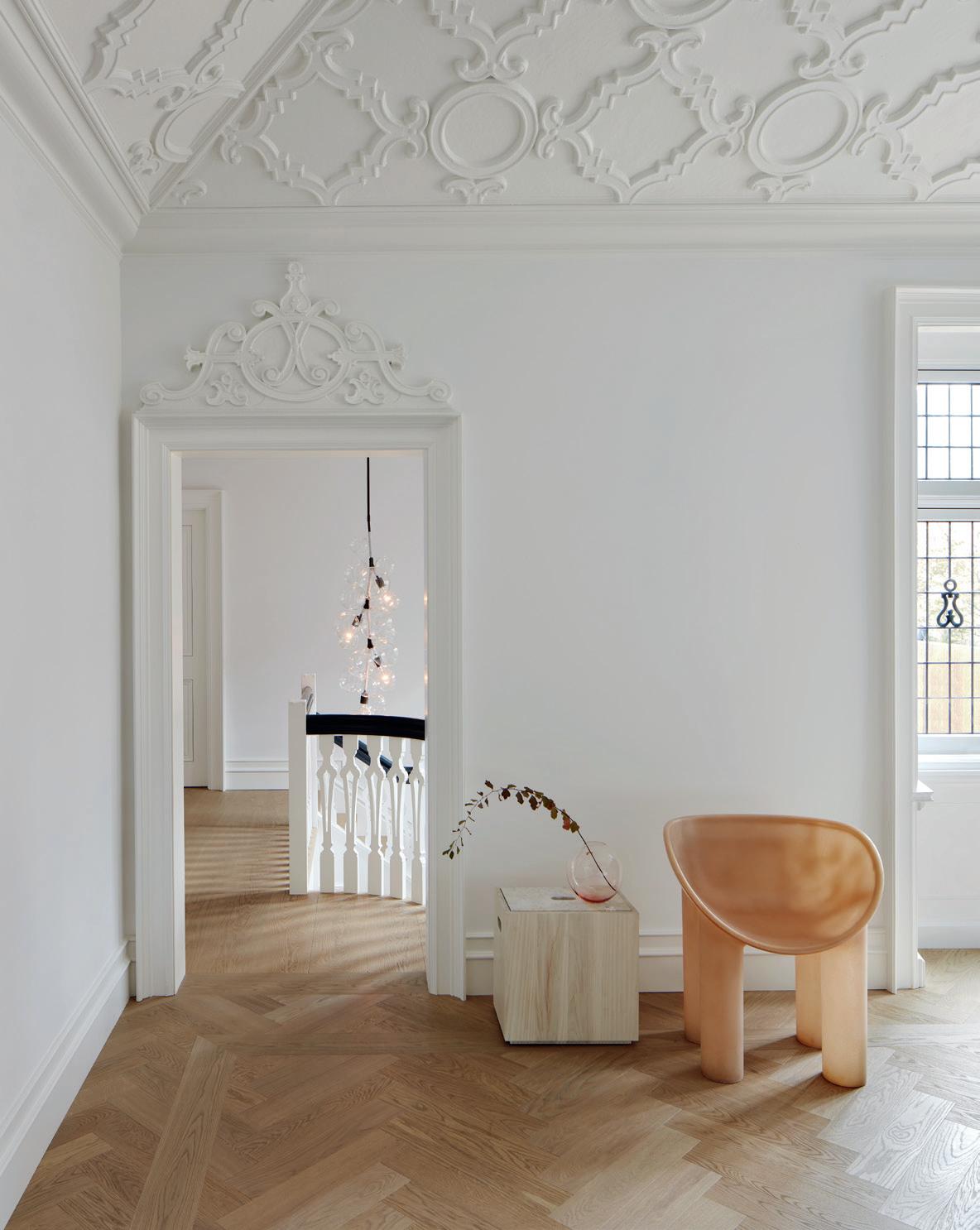

Opposite page — Positioned between two lounge chairs by Christian Liaigre (studioliaigre. com), the OUK2 side table from Toronto firm Avenue Road (avenue-road.com) is one of the sculptural elements that bring formal contrast to the space. In the background, a work from the series Manhattan Maps, by Barbara Macfarlane (barbaramacfarlane.com).
Four wooden sconces (alliedmaker.com) illuminate the hallway, crowned by a vaulted ceiling. In this space, the contemporary doors and mouldings echo the original decorative elements.
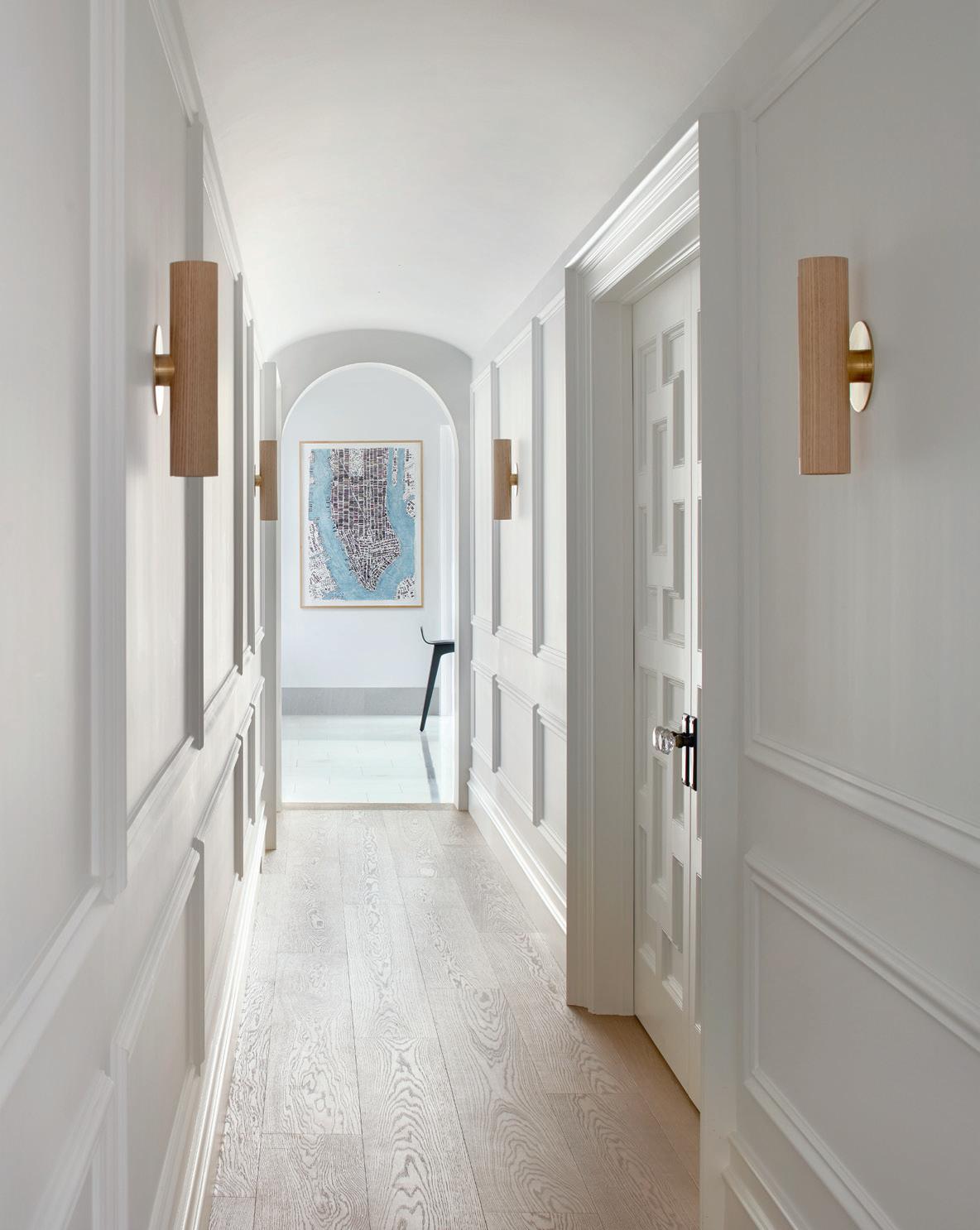
The bright, spacious kitchen pairs curves with linear forms.

Opposite page — Oiled oak and unpolished marble, a timeless and harmonious marriage. Morph barstool (avenue-road.com).
Glass Arc Dome pendant lamps (alliedmaker.com).
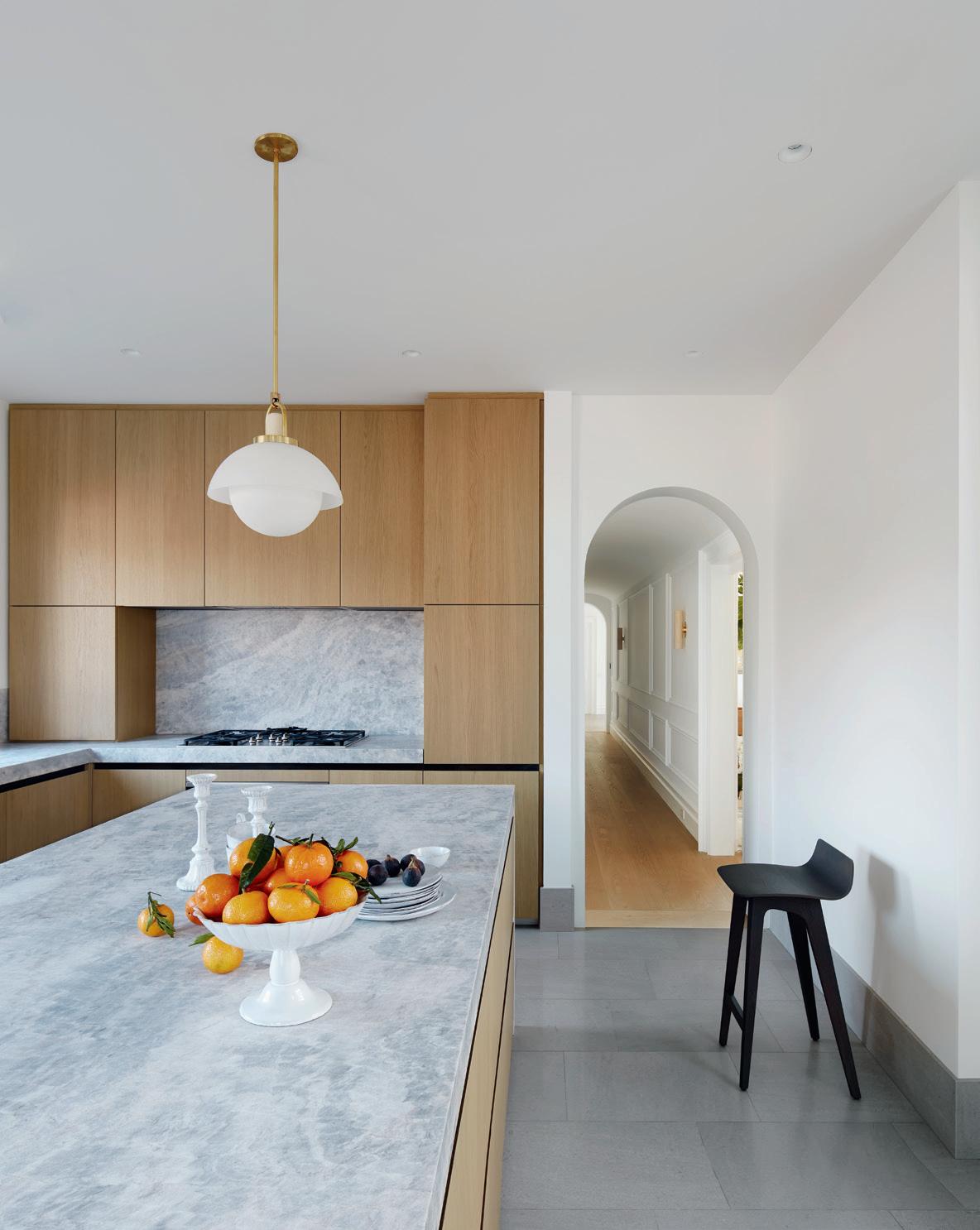
“Art, fashion and design are my main inspirations.”
— Ashley Botten
Beside the Fullham bed by Rodopho Dordoni for Molteni (molteni.it) is a delicate Thin Surface Mount LED wall sconce (juniperdesign.com), produced in Baltimore. Note the savvy use of woodwork on the ceiling to conceal the ventilation hardware.

The primary bedroom combines historical details—leaded glass, for instance—with minimalist furnishings. There are only a few contrasting elements, among them the fireplace mantel, adorned with a framed photo of the Queen of England, by Christopher Wahl (christopherwahl.com). Arctic Pear chandelier (ochre.net). Belle lounge chairs (avenue-road.com).
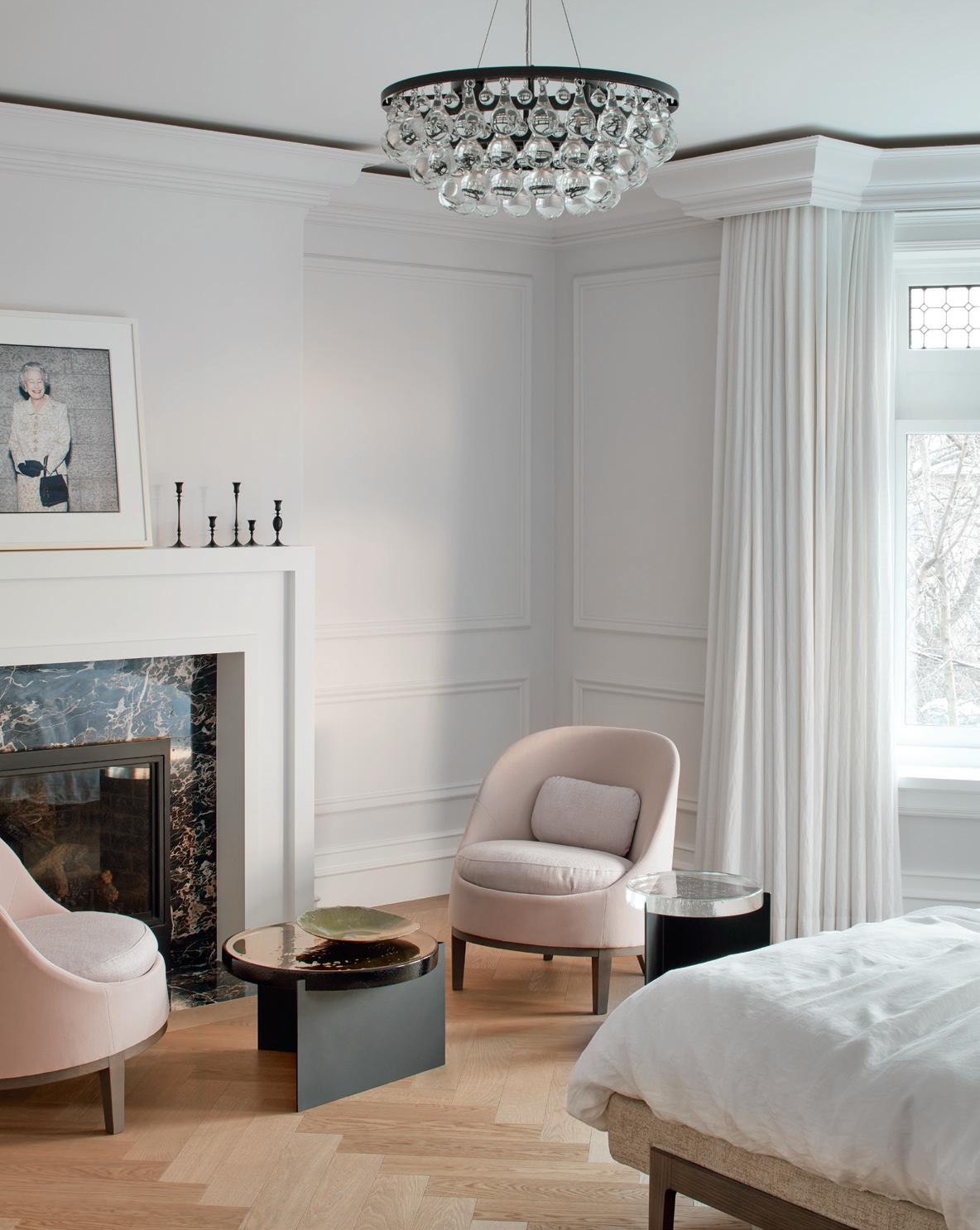
What leads us to choose a particular architect, designer or builder? Perhaps it’s their body of work that convinces us to go with them, or maybe a trusted individual sang their praises. But it’s often because a certain chemistry, a vibe, an unspoken affinity are all at work from the very first face-to-face meeting. When that vibe is lacking, even the most impressive track record and glowing recommendation go by the wayside if we have conflicting feelings and a voice is whispering in our ear, telling us to flee. We go with our instincts. The abstract wins out over the concrete.
Interior designer and architect Ashley Botten is quite conscious of this elusive parallel dimension. She knows how to identify it, and when to heed it.

A SPECIAL MISSION
The project was as follows. A woman in her early sixties, who happens to be the ex-wife of Botten’s father-in-law, acquired a sprawling 3,500-square-foot unit in a former manor that had been split into various living spaces. There is nothing ordinary about this building. It dates to 1915 and sits in the shadow of Casa Loma (literally, house on the hill), the famously opulent castle overlooking downtown Toronto that, to give an idea of its ambitious scale, has 98 rooms and two secret passages. Both structures were designed by E.J. Lennox, an architect who played a leading role in shaping the local landscape in the 20th century, particularly in the Rosedale neighbourhood.
Thus, with this marvellous landmark as a neighbour, the client looked to begin the next chapter of her life with a new partner in a decidedly less ornate home, but an impressive one in its own right. And Ashley Botten, with whom she already had a close connection, didn’t hesitate to join her in this adventure.
“My client,” says Botten, “is a well-travelled, highly involved woman, very athletic and strong, and with great ideas. It goes without saying that we wanted to respect the spirit of the place, its European character. In this historic context, the intention was to create a space with lots of brightness—a serene environment, clean, crisp, but still warm.” Spread out over three floors, the home required a makeover that would strike the right balance between renovation and restoration. “We needed to simultaneously avoid the traps of modernism, fleeting trends and traditionalism,” says Botten. “The aesthetic had to be able to fully express what we are today.”
Although that creative concept resonated in the minds of both women, they still needed to find a contractor who would share their vision and find the precise means to put into action a principle that was both vague and clear. As it turns out, they found the perfect match. “The builder who took this project on literally made the difference between a dream and a nightmare. With him, nothing is impossible,” adds Botten.
The project included redoing mouldings and leaded glass, creating new doors, replacing all flooring with radiant floors, and intricately restoring the stairway. Construction
would last almost two years before the veil was raised on this remade haven, bathed in shades of white punctuated here and there with a touch of vibrant blue or charcoal grey.
“Curiously, finding craftsmen was not so much of a challenge,” says Ashley. The real challenge was in both incorporating and concealing modern lighting, cooling and heating systems, plus audiovisual equipment. In a bedroom, for instance, an opening between the ceiling and wall mouldings allows air to circulate. In the living room, the same function takes place from behind an artwork.
Is there a correct dosage of old elements and contemporary ones, a proper proportion of everyday objects and decorative ones, of shades and textures, that a designer can draw on to produce an elegant yet comfortable formal language that is very much in the here and now? Ashley shrugs and suggests there’s no such formula. Everything has to be felt, instinctively.
“Every project is about the client,” says Botten, and “creating a feeling specifically for that client.” Her work involves designing a coherent interior environment that is both a part of the outside world and a departure from it. For this particular assignment, she wanted to create “a world inside the outside world for two people starting this new life together,” a space where they can move and feel at ease and that respects their individual needs. “It is so much about the way you walk through the house,” she says. “Austere surroundings and severe architecture would have an impact on these two lives.” Indeed. — (ashleybottendesign.com)
This very tone-on-tone bathroom shows its colours in small flourishes, thus highlighting the gold-finish Henry faucets (waterworks.com). Clessidra stool (riva1920.it). Line V sconces (ozonelight.com)
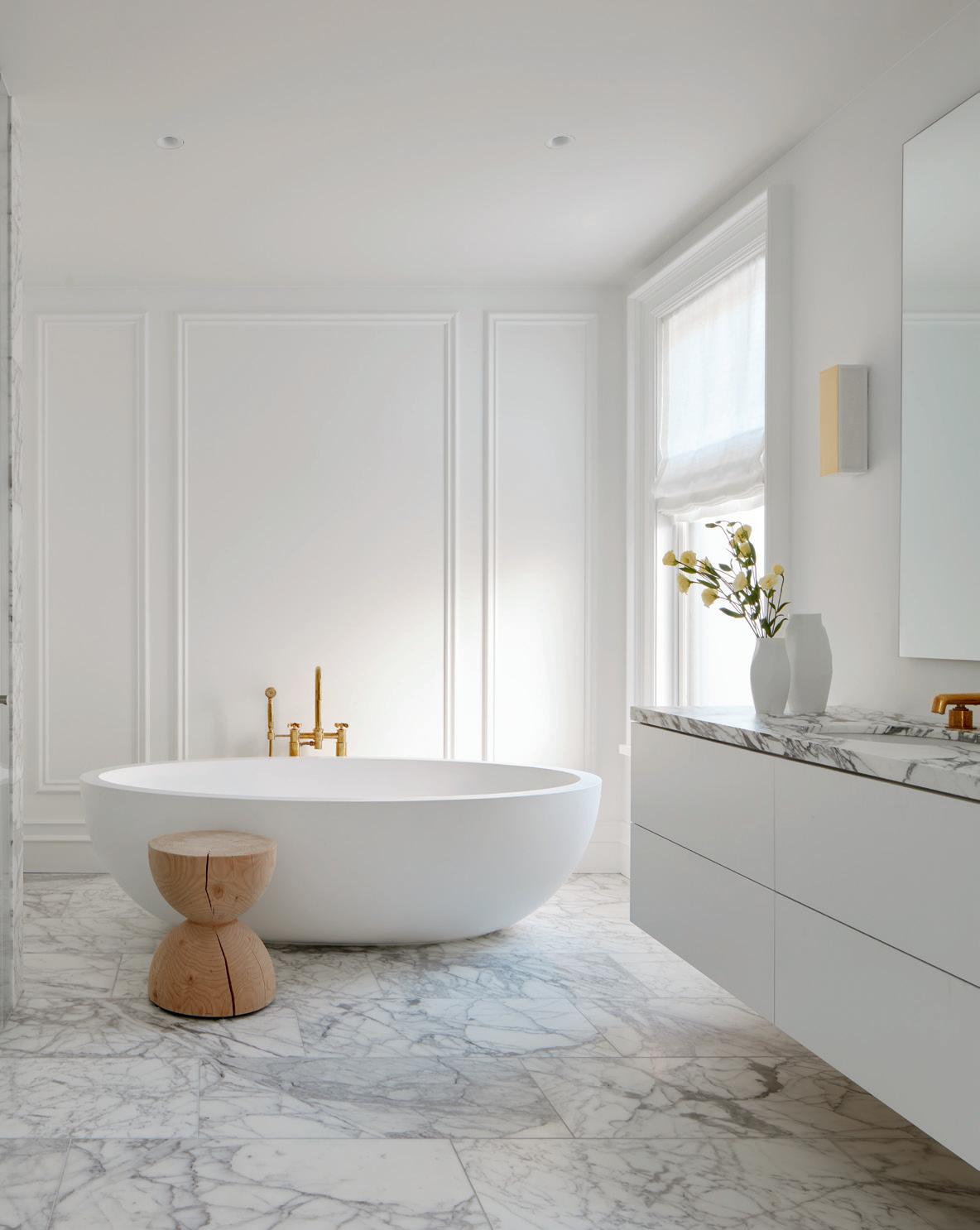
“I love mixing whites. I tend to play more with warm whites, and I don ’ t mix cool and warm. Sometimes, texture is the element that blends them well.”
— Ashley BottenOpposite page — Designer Ashley Botten
Below — Dating from 1916, this facade, typical of the Notre-Dame-de-Grâce district in Montreal, has regained the original characteristics that it had lost.

Below — The owners, Michel and Dominique
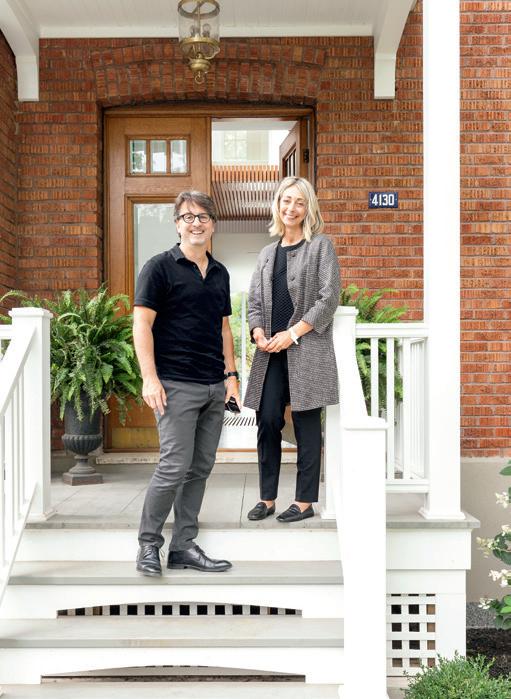
Opposite page — Around the back, a modification to the silhouette, reclaiming the iconic triangular roof shape typical of classic homes in this area, allowed the architects to take advantage of the light offered by a southwestern exposure.
Young parents with older children. Competing needs. A familiar scenario: the desire for light, green space, communal and communicating areas; the quest for modernity without erasing traces of the past. Architectural firm LA SHED not only solved this conundrum, but went above and beyond .
By Céline Tremblay — Adapted by Zarya Rubin — Photographs by Maxime Brouillet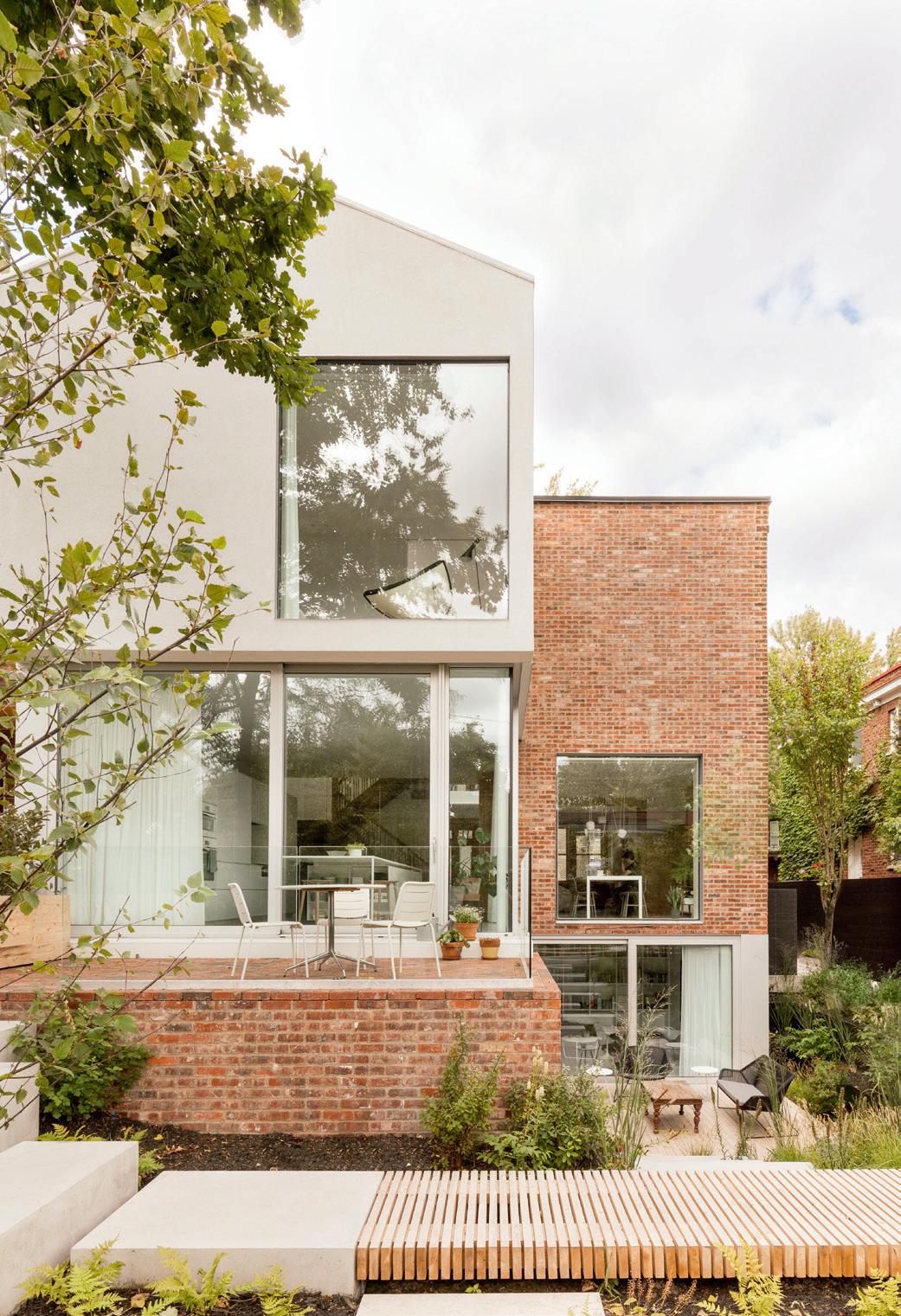
Opposite page — Throughout the home, the original woodwork has been restored. In the dining room, a large window with a hidden frame (shallwin.ca) topped by a vaulted ceiling with ornamental coffers, gives the room a contemporary feel. It is complemented by a minimal amount of furniture: the Aim light fixture by the Bouroullec brothers for Flos (flos.com), a custommade table and six Form chairs from Normann Copenhagen (normann-copenhagen.com).
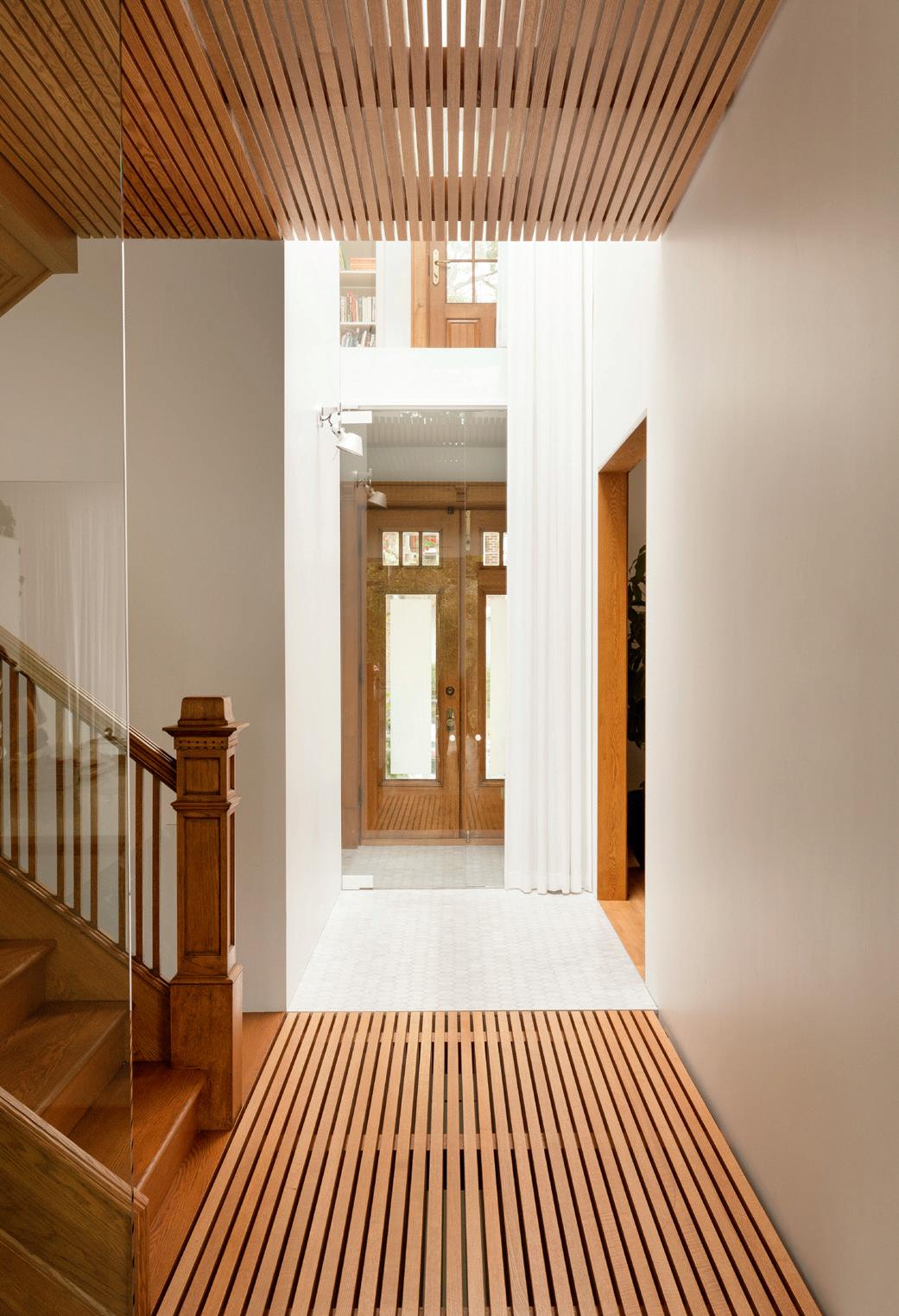
It’s the day of our interview , and Sébastien Parent has forgotten about me. When we eventually meet, he comes running, no excuses, just generous with his time and full of stories to tell. Humble and sincere, the tall, dark-haired young man standing in front of me smiles, and hovering above his beautiful teeth sits a slightly crooked moustache.

I don’t mean to stare, but who could look past the four-leaf clover, the hummingbird and the ginkgo leaf tattooed on his forearm? A little higher up, on his bicep, what looks like a protractor and a staircase catches my eye. In contrast, his left hand sports a sleek, sparkling ring—the kind you might see on the ring finger of a more conventional-looking spouse.
I didn’t know it at the time, but the very DNA of La Shed and its three co-founders was encapsulated in those striking details.
STRIKING A BALANCE La Shed is a Montreal architectural firm based on values; to their great credit, they never let success go to their heads. It is one of the few firms to harbour a consuming passion for urban residential architecture—they wouldn’t shy away from an excavation between two row houses, under a tangle of electrical wires, on a street where truck drivers have a fit when trying to turn and give up when it’s time to find a ↦
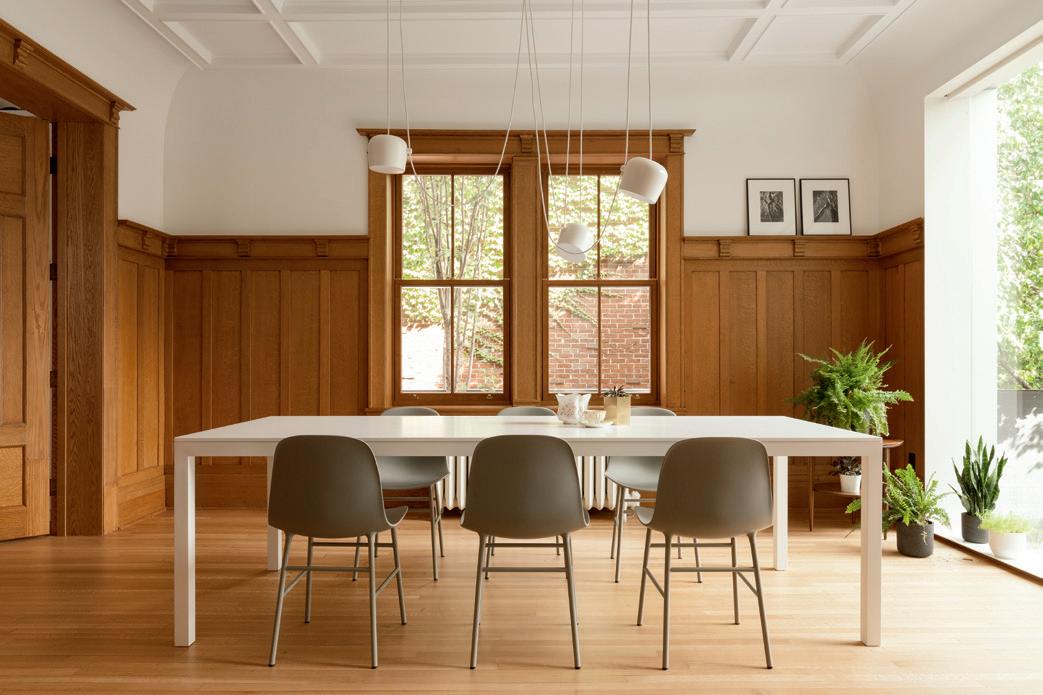


“Acoustics is something that has been carefully addressed in the renovation of the building. Reflective surfaces abound, but sonically, it feels like a library.”
A rectangular opening in the roof allows natural light to travel through the hallways and wooden latticework to reach the ground floor. A Tolomeo wall light from Artemide (artemide.com) takes over in the evening. Hexagonal Italian marble tiling in the kitchen and hallway (ramacierisoligo.com) serves as a contrast to the omnipresent red oak.

The streamlined custom kitchen, designed by La Shed, was built around a slender island topped with Corian (corian.com). It is accented by C401 stools from Kastella (kastella.ca). Miele appliances (miele.ca).

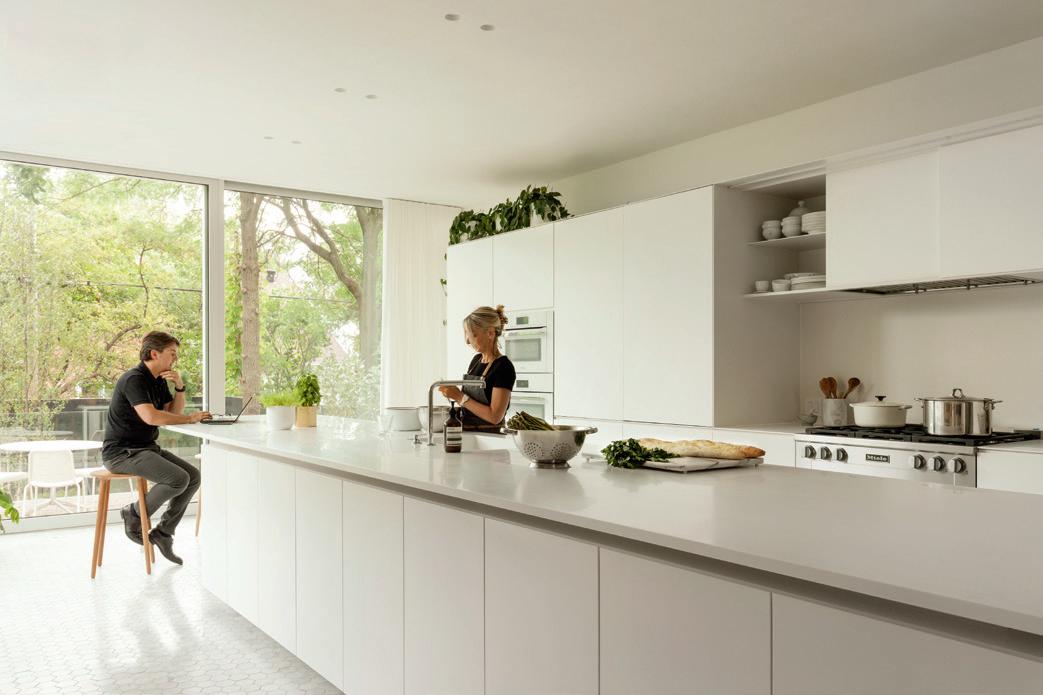


parking spot. They’re also not daunted by the many hurdles involved in obtaining a municipal permit. “Working on small developments,” admits Parent, “can actually be more complex than putting up a skyscraper.”
This two-toned jewel, nestled in Notre-Dame-deGrâce, is a project that is highly representative of the general identity of the trio, which includes colleagues Renée Mailhot and Yannick Laurin. The makeover is not new, but five or six years old.
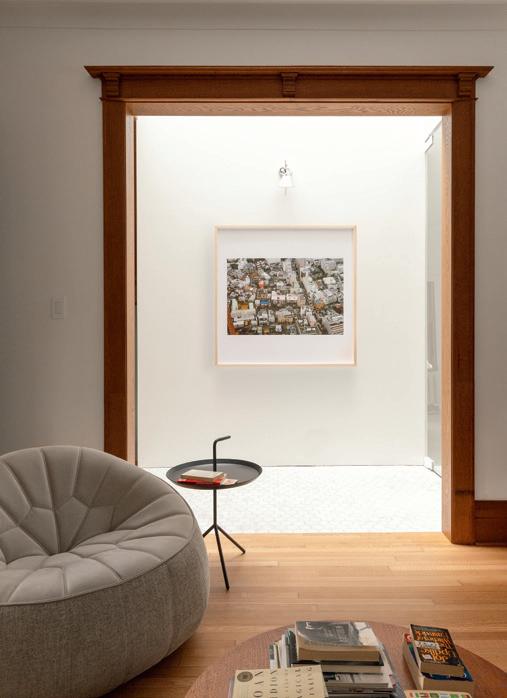
“We’ve received all sorts of awards for this project, and it stands the test of time,” says Parent. “When the day comes that renovations are required, it will be for wear and tear. When we work on a heritage house,” he continues, “there’s a fine line between restoration and alteration. We are always trying to strike a balance between old versus new; the choices we make are often subtle, but impactful. It all has to blend together. This allows history to shine. All of the period pieces have been restored to their original form, and what is modern has been deliberately done in a minimalist way in order to highlight the more elaborate elements like the woodwork, the plasterwork on the ceiling, the original floors and the staircase, which has been opened up.”
“We did a lot of integrating,” he continues. “The original floors were kept even though they creaked a bit. The owners really wanted to retain any elements that had soul. It ended up being more complicated than redoing them, because they rested on hundred-year-old solid wood joists, where we had to place ventilation ducts. That being said, half the surface of the ground floor is shiny and new.”
The architects clearly understood who they were working for. This is what gave the residence a very soothing vibe, with a sumptuousness and scope that are matched only by its simplicity. The house remains modest. It has become more functional, more elegant, much brighter, without losing its humanity. The clients, who have become very good friends, enjoy what they call “the luxury of useless space.”
However, the project did get off to a bit of a bad start. “They had come to meet us at La Shed,” recalls Parent, “and they had to wait for us outside, in the middle of winter. Can you imagine? We were young, and the night before we had celebrated our appearance on the cover of a magazine. We confessed, made no excuses, and I think they found that endearing. You have to think that they appreciated our sincerity and believed in our creative abilities. On a human level, they sized us up. They saw that with us, as with them, what you see is what you get.”
A sin confessed is a sin forgiven. — (lashedarchitecture.com)
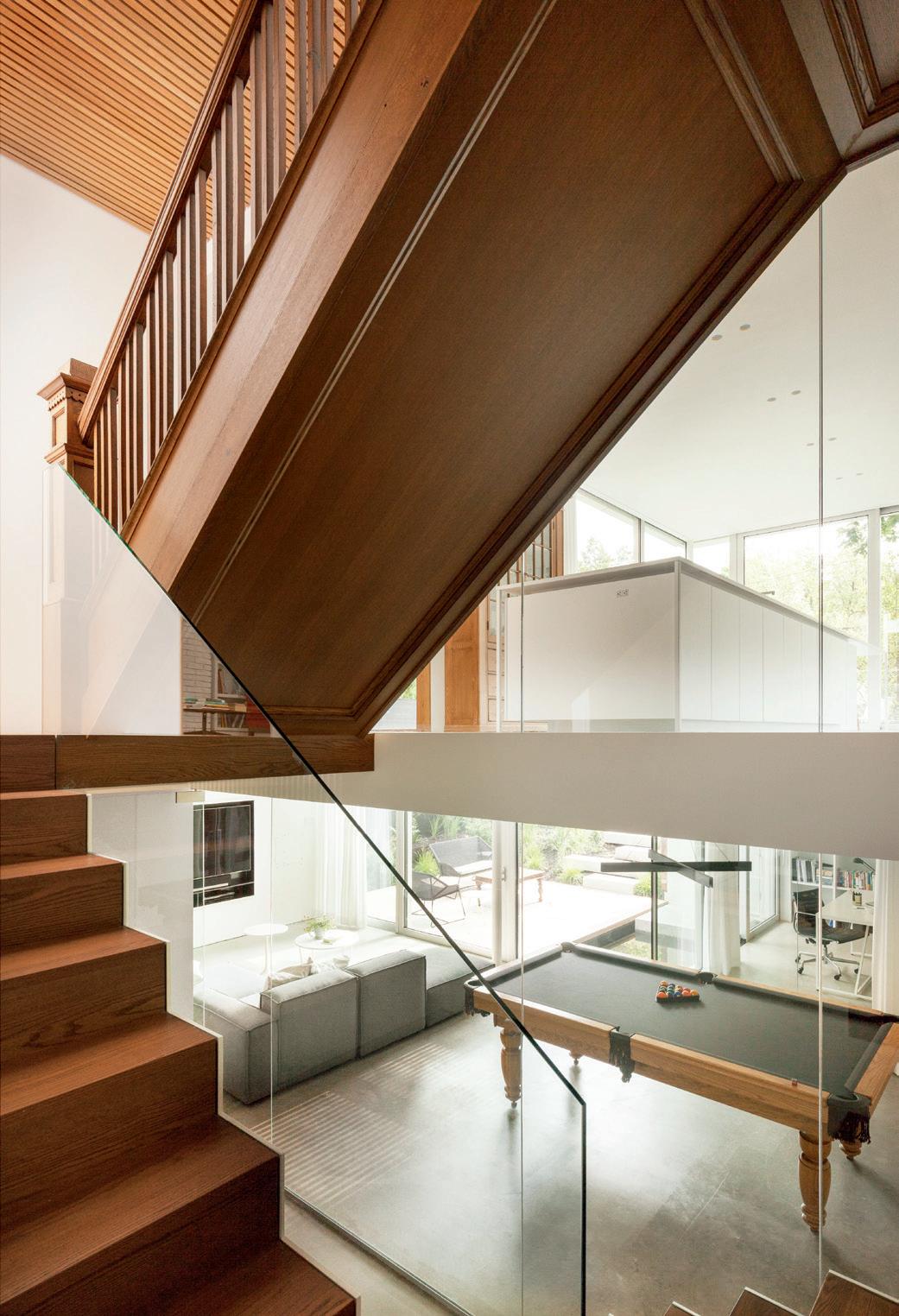
The garden level, once sombre, is now bright and closed off from the neighbourhood. It is bathed in the reflections coming off the decorative pond. Next to the custom-made bookcase are the Domino sofa by Montreal company Romano (romanosofa.com), a side table from Blu Dot (bludot.com) and Eero Saarinen’s Tulip table (knoll.com). Danish Breeze outdoor furniture (cane-line.ca).
“In NDG, semi-detached houses often have raised wooden appendages in the backyard with a deck underneath. They usually have a basic shape with a double-pitched roof. It was an interpretation of this element that created the space that now contains the master bedroom.”

The
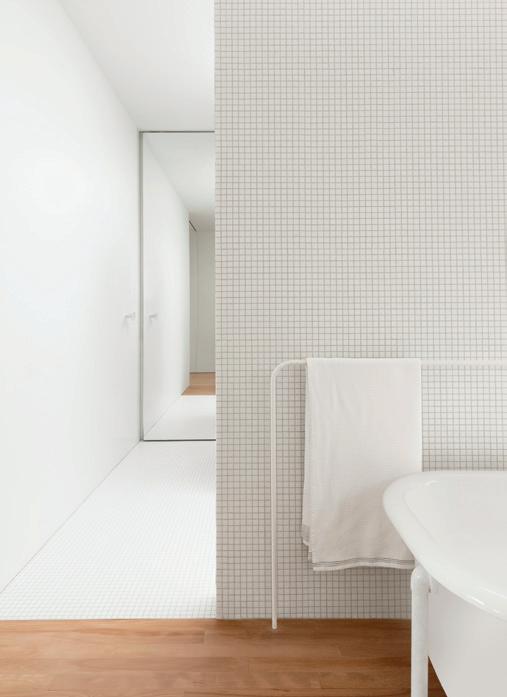



Every home has a story, and Maison Corbeil has helped write many. For the past 50 years, we have been redefining the word “design” to guide our clients in creating spaces that reflect and inspire them. Visit us in-store to discover cutting-edge and iconic designs that transcend time and trends, including Togo by Ligne Roset (1973), Nathalie by Flou (1978), Skorpio by Cattelan Italia (2014) and many more. — (maisoncorbeil.com)
Embrace your inner designer with the Leon modular sectional sofa from Structube. Available in seven colours, its modular pieces and adjustable backrests allow you to mix and match as many seats as you need to create your own custom configuration. A friend to both big rooms and the smallest nooks, this modular sectional sofa is stylish, playful, easy to handle, comfortable and versatile. —
($369 per unit*, structube.com)
* Modular pieces are sold separately. The total price for the sectional sofa pictured is $1,845.




Seventies style has never been more on trend—and with good reason. Defined by saturated bright colours and organic materials, retro interiors stand the test of time while appealing to modern sensibilities. Nowadays, the retro trend embraces the spirit of nostalgia—but with a contemporary twist. See it on curved armchairs, clean-lined furniture, luscious fabrics and neutral tones. Discover them at Mobilia. — (mobilia.ca/en)
This sideboard designed by Giacomo Garziano highlights four fascinating volumes that intersect, creating a shape that boldly opens like two butterfly wings on the top and has two hinged doors on the bottom. Manufactured in Europe and available at Roche Bobois, the Polygonia sculptural storage unit comes in 200 colors, metallic or not. It has FSC Mix certification, which means it’s made with a mix of materials from responsibly managed, FSC-certified forests and other controlled sources. — (roche-bobois.com)
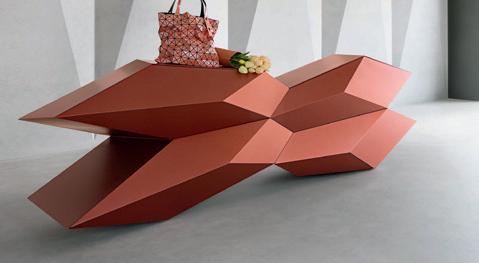
A Truly Mobile Home (PAGE 110) An aesthetically pleasing abode on wheels that blends in perfectly with nature is now available in very limited editions — Perspective (PAGE 114) A place, a moment in time, an emotion —
Showstopper (PAGE 115) A time-travelling object
Like many inventions , this one was born of dissatisfaction. A woman named Anna Ruys wanted to have a multifunctional guesthouse “connected to nature” and wasn’t able to find her perfect fit in the world of prefab. Her son Caspar, intrigued by the challenge, drew up multiple sketches, produced about 10 prototypes and finally succeeded in creating ANNA Collection, a concept home in flat-pack form with a near-zero environmental footprint.
This tiny house is made up of two independent modules, or shells, one of which is fixed while the other slides on articulated rails. On another series of rails, arranged within the modules, sits a glass framework.
The telescopic concept literally reimagines the way we live (I’m choosing my words carefully). The design allows you to change the configuration of the house according to weather, temperature and mood, i.e. probably more than once a day. Sleeping under the stars, cozy in the arms of his family, is an indelible memory of childhood for Caspar Schols, and his

Architects and designers: When you first laid eyes on this little marvel created by a young Dutchman with a degree in…physics, you have to admit that you felt a frisson of excitement. That was in 2016. Since then, the concept has only gotten better.
AdaptedIn its current version, the configuration is designed to perform in a temperate climate, between -20°C and 40°C.

architectural work bears witness to that. Even better, he allows us to experience it, minus the ants crawling up your legs.
In full extension, the living area totals nearly 590 square feet (55 m 2), while once compressed, it comes down to 320 square feet (30 m2). The roof tops out at 15 feet (4.5 m), and this sense of height plays a crucial role in alleviating any fear of claustrophobia.
Four or five days and three humans—that’s all it takes to erect the structure, with a budget of around $640,000, not counting taxes, transport, assembly costs, furniture (which can be included in the order) and planned solar panels on the roof for greater energy efficiency and off-grid freedom. Paradise comes at a price.
In 2022, just 10 prototypes were produced. By 2024, 30 will have been completed. And in 2024, greater access will come via ANNA Collection, a version designed for extreme climates so that this convertible house can be deployed everywhere from Ouarzazate to Iqaluit. ↦

“My father always said, ‘There is no such thing as bad weather, only bad clothing.’ I believe the same principle also applies to architecture.”
— Caspar Schols[1]
No construction waste, no destruction of the surrounding landscape: an attractive, minimalist cocoon filled with light, that can be disassembled, is flexible and is protected from the elements. “I am a hut builder. I will keep building huts my whole life. I don’t believe in mass production,” says Caspar. “ANNA will never be mass-produced. It might get bigger at some point, but I would prefer that its small size be viewed as a plus, in our society where too much is not enough.”
In his preliminary sketchbook, the young creator—who has since furthered his architectural education in London—features a suitcase and an umbrella. The suitcase refers to the thick platform on which the house (the umbrella) is placed. This base ingeniously accommodates a bathtub in its centre. An adjacent area intended to house a retractable bed using a crank invites you to take full advantage of the freed-up space. In all of its forms and configurations, the structure reminds us that it coexists as part of an ecosystem.
ANNA One and ANNA Collection are rustic, but that doesn’t mean you have to sacrifice comfort. The cocoon is, on
While the exterior of the shells is clad in Accoya wood, the interior walls are made from birch plywood.

[1] — The bathtub is covered with a series of narrow panels that are conveniently stored vertically in the floor.
[2] — Given that one of the modules is fixed, four different configurations are possible.
[3] — One of Caspar’s biggest challenges was to make the mobile shell watertight while allowing for the movement of the modules.
the contrary, cozy. Luxurious even, when you think about it—if luxury is defined by the sound of birds, frogs, the light of fireflies, the absence of urban noise and light. That said, it makes you rethink a lot of things. For instance, we tend to design houses according to the property we have. This construction on stilts invites you to do just the opposite, i.e. find the piece of land that best allows you to enjoy all it has to offer. This concept also inevitably raises questions about our use of natural resources, our use of space and our consumption in general. Think outside the box. Caspar thought outside, inside, around and between the boxes. —
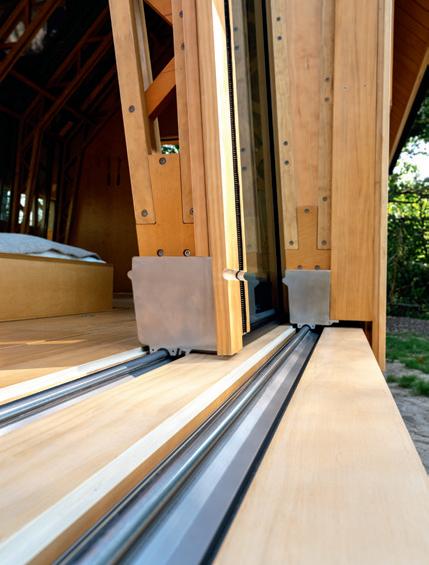
(cabin-anna.com)



This piece, entitled 5.0-S (or Tripod for short), is the work of Brendan Lee Satish Tang, a Canadian artist of mixed Asian descent. It’s a part of his Manga Ormulu sculpture series, which fuses contemporary pop culture—in this case an imaginary manga character—with icons of the Asian tradition. With his powerful yet playful creations, Tang explores their contradictory and complementary strengths. — (brendantang.com) (c24gallery.com) (galleryjones.com)
